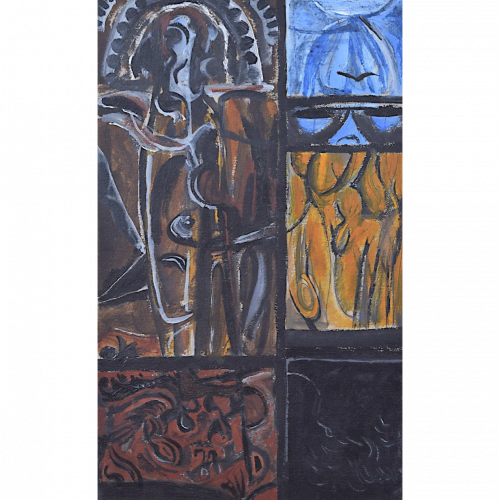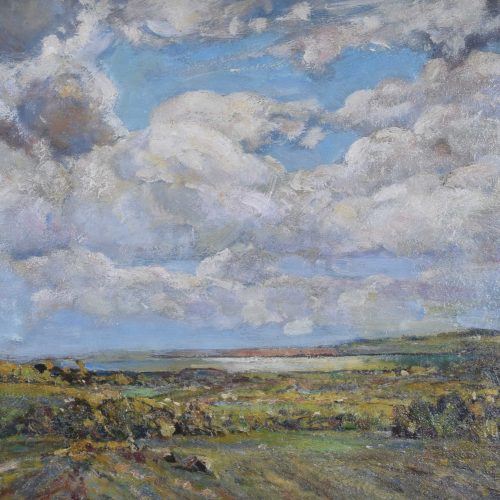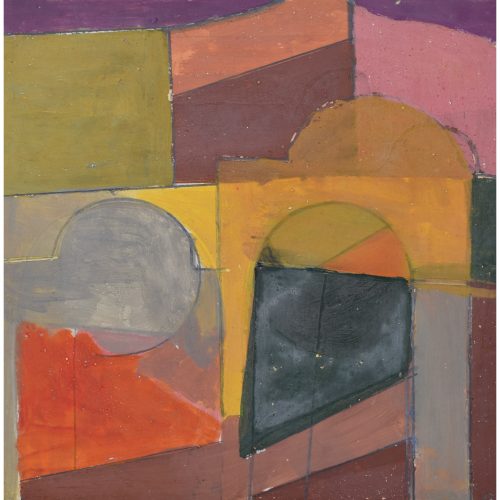-

Angela Stones (1914 - 1995)
Still Life with Fruit and Bottle
Oil on board 39 x 49 cm A stylish mid-century still life. Stones was educated at the Chelsea School of Art, and was a member of an artistic dynasty. Her mother Dorothy Bradshaw (1893-1983) studied under Jack Merriott – the artist famous for his British Rail posters, and her son, Christopher Assheton-Stones (1947-1999), was arguably the foremost pastel artist of his time. Provenance: the family of the artist. Condition: Generally very good. If you’d like to know more, please email info@manningfineart.co.uk or call us on 07929 749056. -
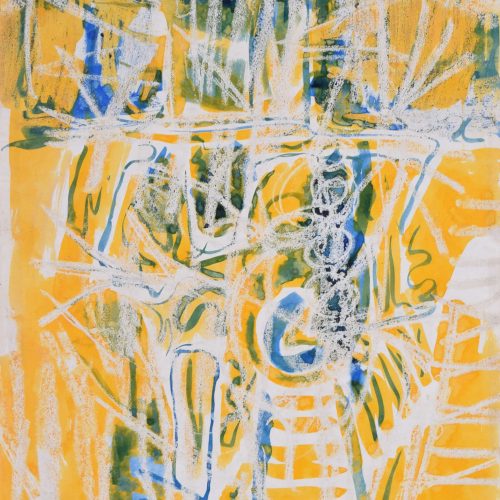
Charles Pulsford ARSA (1912 - 1989)
Abstract Figure in Yellow and Blue
Watercolour and ink 56 x 38 cm Signed lower right. An abstract figure in arresting colours. The artist plays with the intersection of round and lateral mark-making to form a human figure, perhaps reminiscent of a crucifixion. Pulsford's skill as an abstract landscape artist is also evident here, with the form suggestive of natural and industrial topography like fields, rivers, railway tracks, and electric pylons. Pulsford was born in Staffordshire to Scottish parents. His family returned to Dunfermline when he was a child, and he subsequently attended Edinburgh College of Art (ECA) between 1933 and 1937. He, along with other prominent Scottish artists, embraced modernism and abstraction following the end of the war. Alan Davie, William Turnbull, William Gear and Eduardo Paolozzi are the key artists of the group with which he was association, and the National Galleries of Scotland regard Pulsford as the 'fifth man' of the group. Between 1952 and 1960 he taught at ECA and then at Canterbury College of Art. Condition: generally very good, old tape stains to extreme margins. If you are interested email info@manningfineart.co.uk or call us on 07929 749056. Provenance: the artist, the residual stock of William Hardie. -
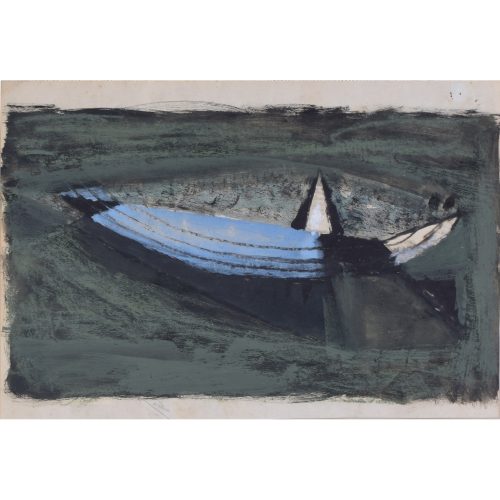
Clifford Ellis (1907-1985)
Coming of the Ice Age I
Watercolour 16x25cm For the artist's biographical details and to see the other three designs from this series available for sale please click here. If you are interested email info@manningfineart.co.uk or call us on 07929 749056. -
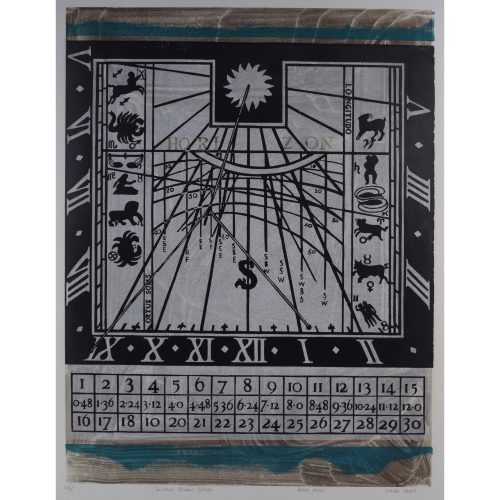
Walter Hoyle
Queens' College Cambridge, Sundial
Linocut, 1965 76x57 cm Signed numbered and titled in pencil. Printed on handmade Japanese Hosho paper by the artist at Editions Electo Click here for biographical details and other works by the artist. If you are interested email info@manningfineart.co.uk or call us on 07929 749056. -
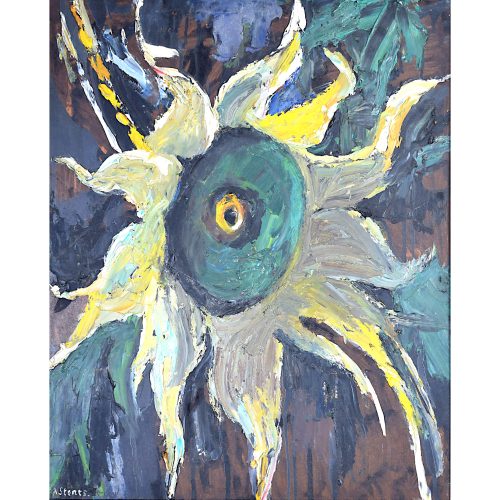
Angela Stones (1914-1995) Helianthus
Oil on canvasboard 44x55cm Signed lower left Stones was a member of an artistic dynasty. Her mother Dorothy Bradshaw (1893-1983) studied under Jack Merriott - the artist famous for his British Rail posters, and her son, Christopher Assheton-Stones (1947-1999) was probably the foremost pastel artist of his time. Here a generous use of impasto captures the texture of a Helianthus - Sunflower. A suggestion perhaps of surrealism in choice of colours helps with the mid-century feel of the painting. If you are interested email info@manningfineart.co.uk or call us on 07929 749056. Condition: Good. -
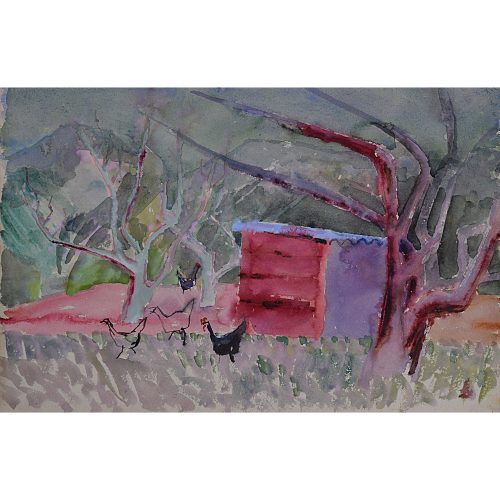
Clifford Ellis (1907-1985) Hens by a chicken shed at Corsham Court
Watercolour 37x56cm Provenance: the family of the artist, by descent. Here Ellis paints the hens at Corsham Court together with their chicken shed. Born in Bognor in Sussex and trained at St Martin’s School of Art and Regent Street Polytechnic, Ellis was a graphic artist and illustrator who is best known for the posters he produced for London Transport during the 1930s. He generally collaborated with his wife Rosemary – whom he married in 1931 – on their posters. The General Post Office, Shell, and The Empire Marketing Board were also clients for their posters. They signed their posters C&RE, their initials being in alphabetical order and they are readily recognisable by their ebullient use of colour and form. Employed during the war as a camoufleur, along with so many other artists, Clifford was also an official war artist, serving with the Grenadier Guards. Rosemary, meanwhile, was an artist for the Recording Britain project. Following the war they trained art teachers at Bath Academy of Art. They also designed a series of nearly one hundred book jackets for Collins New Naturalist series, published between 1945 and 1982. Clifford Ellis studied illustration at the Regent Street Polytechnic, an institution that specialised in ’practical trade classes’, from 1924-27. He went on to design book covers (notably for Collins’ ‘New Naturalist’ series) and posters for London Transport, the General Post Office, Shell-Mex, the Empire Marketing Board and J. Lyons & Co., along with his wife, Rosemary Ellis, whom he married in 1931 while he was teaching at the Polytechnic. The couple’s poster designs combine striking colour with bold typography and depict stylised scenes of the countryside, birds and animals. In the 1930s London Transport commissioned over forty posters a year from well-known artists such as Laura Knight, CRW Nevinson, Edward Wadsworth, Eric Ravilious, Paul Nash, Graham Sutherland and Edward McKnight Kauffer – a bold policy that did much to popularise avant-garde artistic styles that stemmed from Cubism, Futurism and Abstraction. Such an influence is clear in the Ellises poster ‘It’s better to shop early’ (above, 1935) in which arms, hands and parcels are disjointed and angular with the text on a slant, like the collaged newsprint insertions of synthetic Cubism. This strong foundation in graphic art clearly influenced his approach to composition for the rest of his career. Even his later abstract work, though tonally subtle, is based on a simple but powerful linear design. ‘The Coming of the Ice Age’, a series of watercolour and crayon studies (one large finished canvas, ‘Advance of an Ice Age’, exists in the collection of Derbyshire and Derby School Library Services) reduces natural forms to simplified shapes and colour planes, though retaining the texture of brushstrokes and crayon. The Ellises visited the Devon coastal town of Teignmouth to carry out a commission for Lyons for a lithograph in 1947, and the rocky bay with its whitewashed buildings and sailboats (below) caught Clifford’s imagination. He painted numerous preparatory watercolour views for the lithograph, while both the grey-blue colour palette as well as the pleasing repetitive geometry of sails reflected on water might be discerned in later abstract works. During the Second World War Ellis served as a camouflage artist and official war artist with the Grenadier Guards. Roland Penrose was another British artist who worked in this area and wrote ‘The Home Guard Manual of Camouflage’ which effectively adapted modern painting techniques for use in warfare. The tonal colour range of many of Ellis’s post-war paintings and the abstract network of shapes – for instance the pale blue patchwork ‘glacier’ in the ‘Coming of the Ice Age III’ (below) – seem to hark back to the art of the modernist camoufleur. Ellis played another important role during the war, painting and drawing scenes of Bath for the Recording Britain project. This project was conceived by Kenneth Clark, then Director of the National Gallery, alongside the official War Artists scheme; its aim was to document Britain’s landscape and architectural heritage in the face of the imminent threat of invasion and bomb damage. It also had a propaganda motive; the resulting works were exhibited during the war and aimed to boost the nation’s morale (they are now in the collection of the V&A). The paintings were predominantly in watercolour, a traditional British medium that Clark was keen to promote and felt would complement the subject matter. Two of Ellis’ pupils, discussing his watercolour sketch of VE Day in Bath, recall him as quietly observant but also someone who enjoyed life; the painting is spontaneous and full of the movement of dancing figures and waving flags. In particular, Ellis was commissioned to depict examples of Bath’s decorative architectural ironwork before it was removed to help the war effort and he also recorded the effects of bombing raids on the city. Meanwhile Ellis had joined the staff of the Bath School of Art (or Bath Technical College). Its temporary residence was destroyed by bombs in 1942 and Walter Sickert’s house at Bathampton offered as a refuge (Sickert, who had taught at the School, died in January 1942). After the war the School began its transformation into the Bath Academy of Art based at Corsham Court, of which Ellis was the Head from 1937-72, training art teachers and developing a pioneering new syllabus. If you are interested email info@manningfineart.co.uk or call us on 07929 749056. Condition: Excellent. In a conservation mount. -
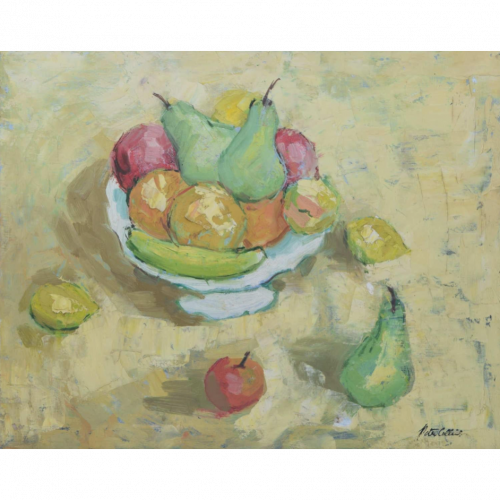
Peter Collins ARCA (1923-2001)
Still Life of a Fruit Bowl (c. 1960s)
Oil on canvas 40 x 51 cm Signed lower right. A stylish mid-century still life with fruit. Collins's first job was at an advertising agency, in the commercial studio. World War II interrupted his career and he joined the Royal Artillery (of the British Army), teaching painting and drawing in the Education Corps - whilst simultaneously teaching at St Martin's School of Art, part time. Following the war, Collins studied at the Royal College of Art, winning a scholarship. He then worked as a commercial artist, producing some well-known posters for clients including British Railways and British European Airways. He was the Art Director at Odhams Press and spent time designing for both ICI and Shell. With his wife Georgette, he created the 'Bacombe Galleries' in Sussex, converting a group of buildings into a gallery space. In 1975 they developed the Stanley Studios in Chelsea, which were scheduled for redevelopment, into a combined artists' studio and residence. Moving into the Stanley Studios allowed the Collinses to immerse themselves in Chelsea's art scene, and they proceeded to fill the studios with art, antiques, scupture, and other curios. Provenance: the artist's studio sale 2017, lot 2050. Condition: very good. -
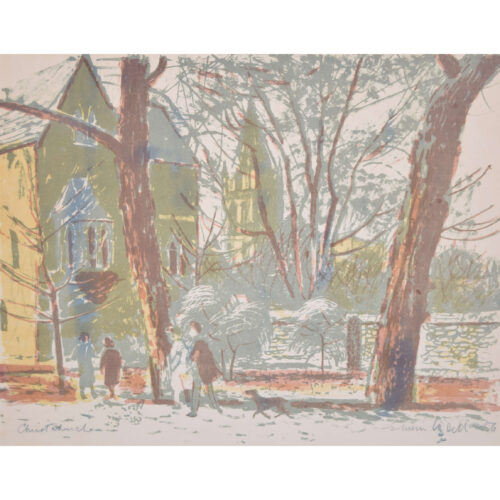
Edwin La Dell (1914-1970)
Christ Church, Oxford (1956)
Lithograph 33 x 42 cm Signed and dated lower right. With invoice from Royal Academy and letter from the artist. This view of Christ Church from the meadows is rendered in a muted palette, suggestive of a late autumn afternoon. Four coat-and-hat-clad pedestrians stroll along, accompanied by small child and dog. La Dell studied at the Sheffield School of Art, where he won a scholarship to the Royal College of Art. From 1934 to 1940 John Nash was the head of printmaking there, and taught La Dell. La Dell himself became head of lithography there in 1948, and remained in post until his death. During the war La Dell was an official war artist and a camofleur, but he is probably best known for his lithographs of Oxford and Cambridge that he published himself. His works are widely held in the public collections, including the Royal Academy and the Government Art Collection, the latter of which holds many of his views of Cambridge. Condition: mounted to board. Slight but even age toning. If you are interested, please email info@manningfineart.co.uk or call us on 07929 749056. Click here for other views of Christ Church. -
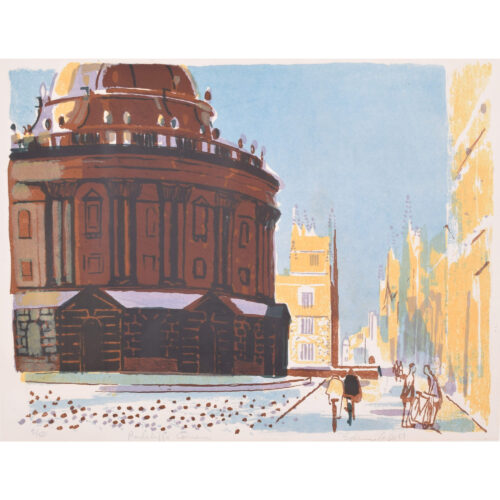
Edwin La Dell (1914-1970)
The Radcliffe Camera, Oxford
Lithograph 41 x 54 cm Numbered 2/50, titled, and signed below in pencil. Radcliffe Square in autumn shades. The Radcliffe Camera dominates the lithograph, and La Dell expertly captures the afternoon sun on the golden stone of Brasenose and the University Church. Students cycle towards the High. La Dell studied at the Sheffield School of Art, where he won a scholarship to the Royal College of Art. From 1934 to 1940 John Nash was the head of printmaking there, and taught La Dell. La Dell himself became head of lithography there in 1948, and remained in post until his death. During the war La Dell was an official war artist and a camofleur, but he is probably best known for his lithographs of Oxford and Cambridge that he published himself. His works are widely held in the public collections, including the Royal Academy and the Government Art Collection, the latter of which holds many of his views of Cambridge. Condition: generally very good. Fractional age-toning to paper; old glue marks to margin which will be under the mount when framed. If you are interested, please email info@manningfineart.co.uk or call us on 07929 749056. Click here for other general views of Oxford. -
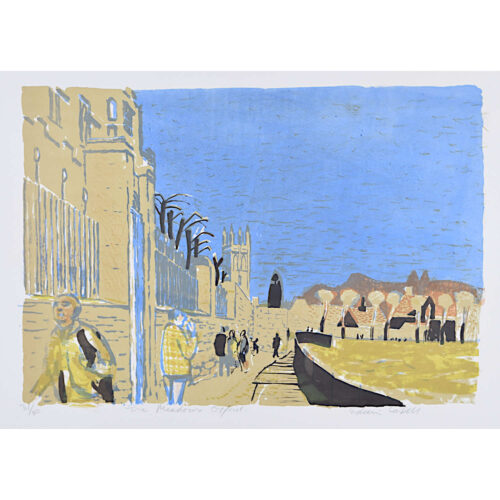
Edwin La Dell (1914-1970)
The Meadows, Oxford
Lithograph 40 x 55 cm Signed, titled, and numbered 31/80 in pencil. A bright blue winter sky looks over Christ Church Meadows, complete with pedestrians waltzing down Deadman's Walk. La Dell studied at the Sheffield School of Art, where he won a scholarship to the Royal College of Art. From 1934 to 1940 John Nash was the head of printmaking there, and taught La Dell. La Dell himself became head of lithography there in 1948, and remained in post until his death. During the war La Dell was an official war artist and a camofleur, but he is probably best known for his lithographs of Oxford and Cambridge that he published himself. His works are widely held in the public collections, including the Royal Academy and the Government Art Collection, the latter of which holds many of his views of Cambridge. Condition: very good. Backed to linen. If you are interested, please email info@manningfineart.co.uk or call us on 07929 749056. Click here for other views of Christ Church. -
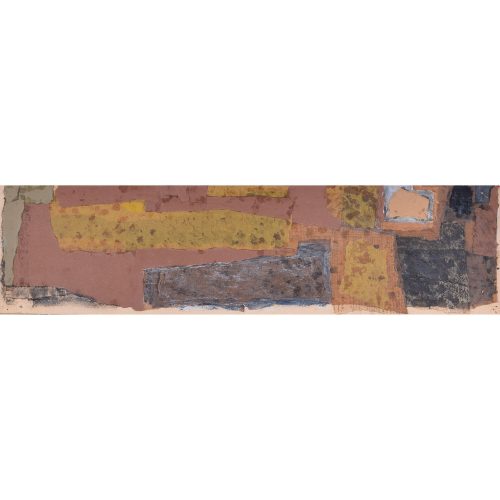
Clifford Ellis (1907-1985)
Collage I
Collage 13x56cm Click here for biographical details and other works by the artist If you are interested email info@manningfineart.co.uk or call us on 07929 749056. -
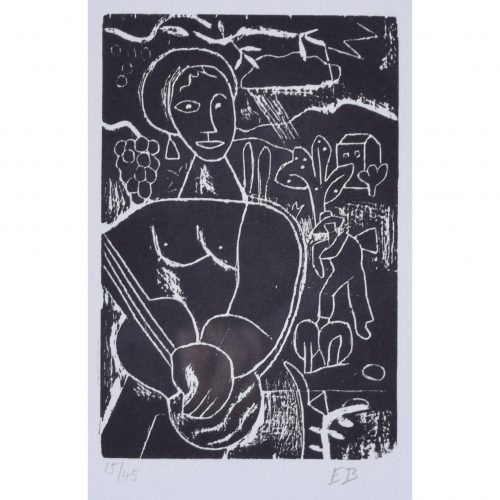
Edward Burra (1905 - 1976)
The Guitar Player
(1928 - 1929, this edition published 1971) Woodcut 15 x 10 cm; sheet size 34 x 24 cm Numbered 15/45 lower left and initialled EB lower right. Burra's woodcut of a female guitar player surrounded by a landscape of cacti. A bunch of grapes is pendent beside her triangular earring, and a male figure in a wide-brimmed hats stands in the field nearby. Edward Burra was an English painter, draughtsman, and printmaker. He travelled to Italy in 1925, the same year he met the noted British Surrealist Paul Nash, and both of these influences are evident in this woodcut. Nash introduced Burra to woodcut-making in 1928, the same year that Burra began this woodcut series. His first solo show was held at the Leicester Galleries in April 1929, and he exhibited with the English Surrealists in the 1930s. Condition: Excellent. If you’d like to know more, please email info@manningfineart.co.uk or call us on 07929 749056. -
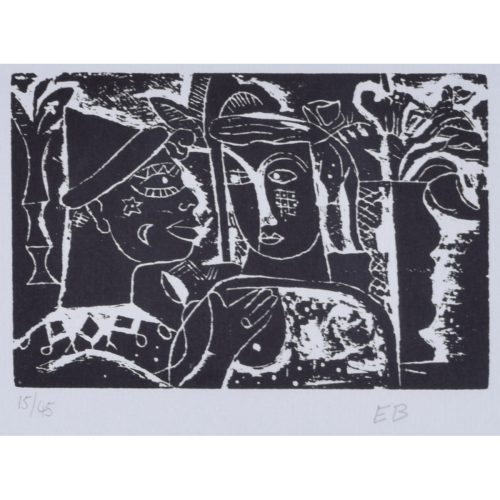
Edward Burra (1905 - 1976)
Café
(1928 - 1929, this edition published 1971) Woodcut 10 x 15 cm; sheet size 24 x 34 cm Numbered 15/45 lower left and initialled EB lower right. Published by the Nicholas Treadwell Gallery in 1971. Burra's woodcut of a male and a female figure, entitled 'Café'. The two figures, seemingly a couple, gaze at one another intensely and intimately, giving the impression of having been interrupted by the viewer. Both figures' faces bear tattoo-like markings: he a star and the moon, she a geometric design resembling a noughts-and-crosses board. The "café" in which they sit is a dreamily abstract landscape full of palms and other plants from the tropics. Edward Burra was an English painter, draughtsman, and printmaker. He travelled to Italy in 1925, the same year he met the noted British Surrealist Paul Nash, and both of these influences are evident in this woodcut. Nash introduced Burra to woodcut-making in 1928, the same year that Burra began this woodcut series. His first solo show was held at the Leicester Galleries in April 1929, and he exhibited with the English Surrealists in the 1930s. Condition: Excellent. If you’d like to know more, please email info@manningfineart.co.uk or call us on 07929 749056. -
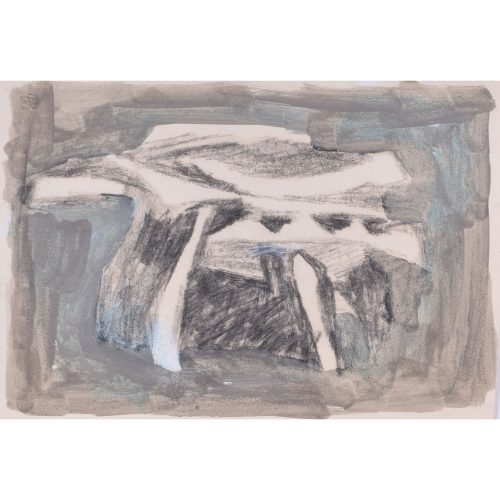
Clifford Ellis (1907-1985)
Form
Gouache 21x30cm Provenance: the family of the artist, by descent. Click here for biographical details and other works by the artist. If you are interested email info@manningfineart.co.uk or call us on 07929 749056. -

Julian Trevelyan (1910-1988)
St James' Park (1969-70)
Etching and aquatint, signed, numbered 48/75 35x48cm Click here for biographical details and other works by the artist. If you are interested email info@manningfineart.co.uk or call us on 07929 749056. -

Julian Trevelyan (1910-1988)
Richmond (1969)
Etching and aquatint, signed, numbered 47/75 48x35cm Click here for biographical details and other works by the artist. If you are interested email info@manningfineart.co.uk or call us on 07929 749056. -

Julian Trevelyan (1910-1988)
Kensington Gardens (1969)
Etching and aquatint, signed, numbered 55/75 35x48cm Click here for biographical details and other works by the artist. If you are interested email info@manningfineart.co.uk or call us on 07929 749056. -
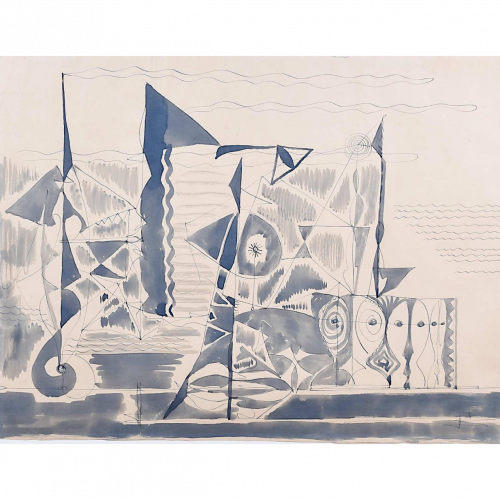
Charles Pulsford ARSA (1912-1989)
Abstract Harbour
Watercolour 36 x 46 cm Signed lower right. Pulsford was born in Staffordshire to Scottish parents. His family returned to Dunfermline when he was a child, and he subsequently attended Edinburgh College of Art (ECA) between 1933 and 1937. He, along with other prominent Scottish artists, embraced modernism and abstraction following the end of the war. Alan Davie, William Turnbull, William Gear and Eduardo Paolozzi are the key artists of the group with which he was association, and the National Galleries of Scotland regard Pulsford as the 'fifth man' of the group. Between 1952 and 1960 he taught at ECA and then at Canterbury College of Art. Provenance: the artist, the residual stock of William Hardie Gallery. Condition: Generally very good, in fine hand-finished frame. If you are interested, email info@manningfineart.co.uk or call us on 07929 749056. -
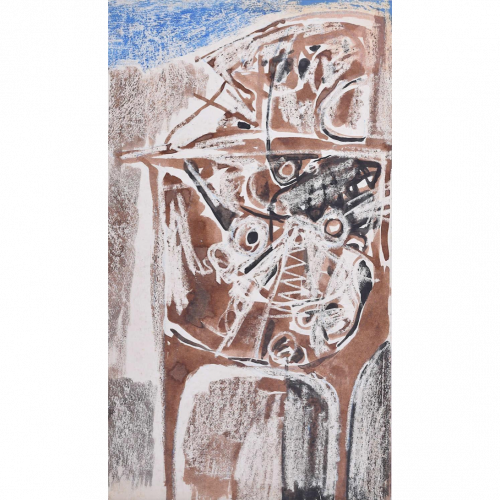
Charles Pulsford ARSA (1912-1989)
Abstract Landscape
Watercolour with wax resist 55 x 31 cm Provenance: the artist; the residual stock of William Hardie. Pulsford was born in Staffordshire to Scottish parents. His family returned to Dunfermline when he was a child, and he subsequently attended Edinburgh College of Art (ECA) between 1933 and 1937. He, along with other prominent Scottish artists, embraced modernism and abstraction following the end of the war. Alan Davie, William Turnbull, William Gear and Eduardo Paolozzi are the key artists of the group with which he was association, and the National Galleries of Scotland regard Pulsford as the 'fifth man' of the group. Between 1952 and 1960 he taught at ECA and then at Canterbury College of Art. Condition: Generally very good. If you are interested, please email info@manningfineart.co.uk or call us on 07929 749056. -
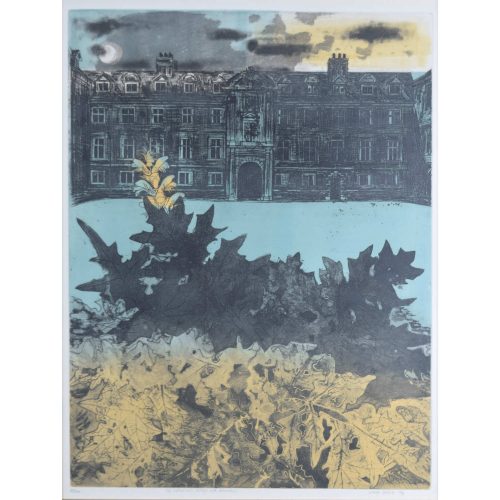
Walter Hoyle (1922-2000)
St Catharine's College, Cambridge (1973)
Linocut 72 x 56 cm Signed and dated '73 lower right, numbered 85 / 200 lower left, and signed below. Hoyle trained at Beckenham School of Art and the Royal College of Art. At the RA, he was strongly influenced by Edward Bawden, one of Britain’s greatest linocut printers. Bawden had been commissioned by the 1951 Festival of Britain to produce a mural for the South Bank, and chose Hoyle, a promising student, as his assistant. Hoyle moved to Great Bardfield in Essex and became part of the Great Bardfield group of artists: diverse in style, they created figurative work in stark contrast to the abstract art of the St Ives artists at the other end of the country. Hoyle taught at St Martin’s School of Art from 1951 - 1960, the Central School of Arts and Crafts from 1960 - 1964, and the Cambridge School of Art from 1964 - 1985, during which time he launched Cambridge Print Editions. His work is held in the collections of the Tate Gallery, the Victoria and Albert Museum, The British Museum, Kettle’s Yard, and the Fry Art Gallery. Condition: very good. If you are interested, please email info@manningfineart.co.uk or call us on 07929 749056. -
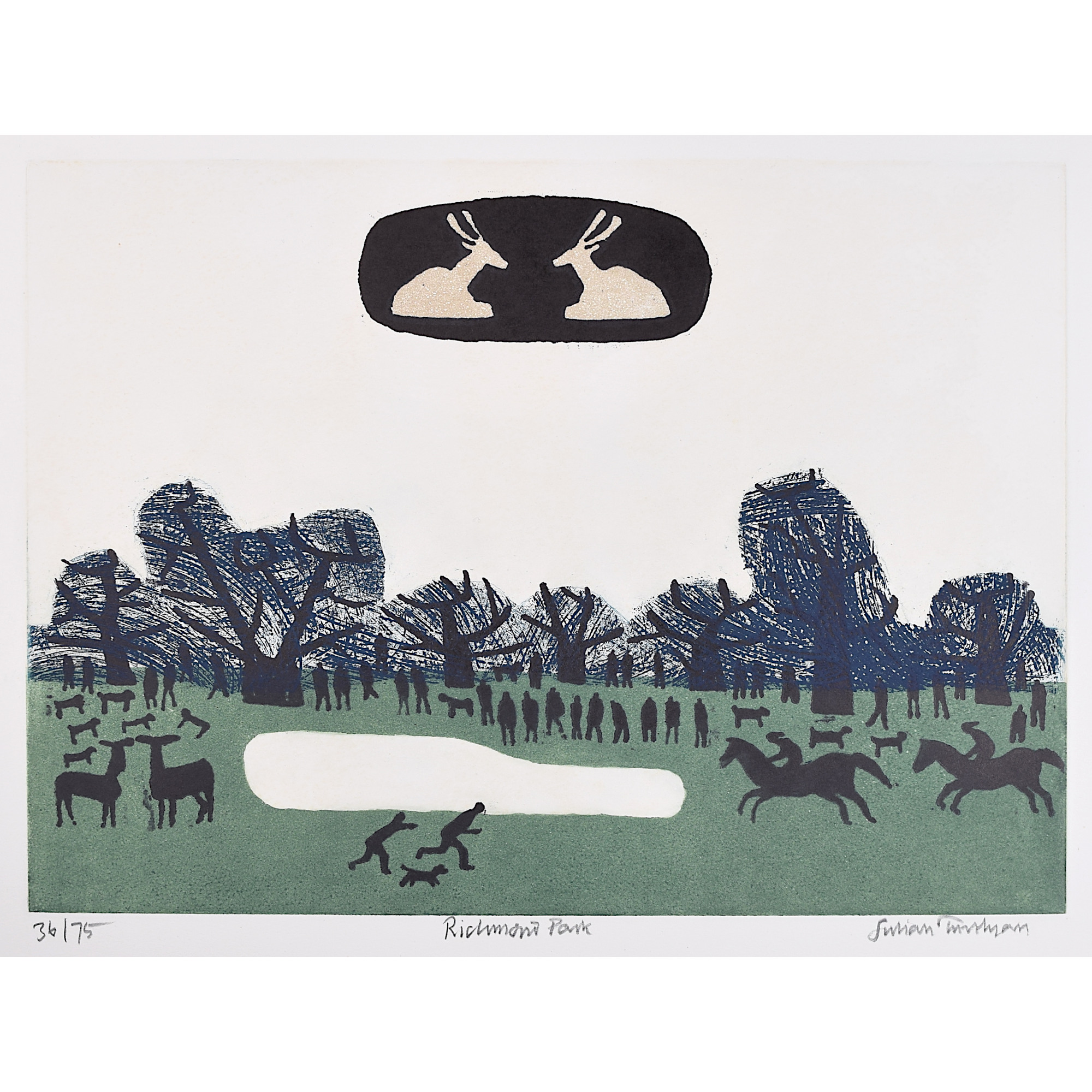
Julian Trevelyan (1910-1988)
Richmond Park (1969)
Etching and aquatint, Signed, numbered 36/75 35x48cm (sheet size 59x77cm) On J Green paper from the Thames Suite Click here for biographical details and other works by the artist including several others from the Thames Suite. If you are interested email info@manningfineart.co.uk or call us on 07929 749056. -

Angela Stones (1914 - 1995)
Still Life with Fruit and Flowers
Oil on board 62 x 46 cm A typically stylish mid-century still life. The citrus fruits in the foreground are the painting's focus, with their peel dancing between reds, greens, yellows, and oranges. Stones was educated at the Chelsea School of Art, and was a member of an artistic dynasty. Her mother Dorothy Bradshaw (1893-1983) studied under Jack Merriott – the artist famous for his British Rail posters, and her son, Christopher Assheton-Stones (1947-1999), was arguably the foremost pastel artist of his time. Provenance: the family of the artist. Condition: very good; recently cleaned and varnished. If you’d like to know more, please email info@manningfineart.co.uk or call us on 07929 749056. -
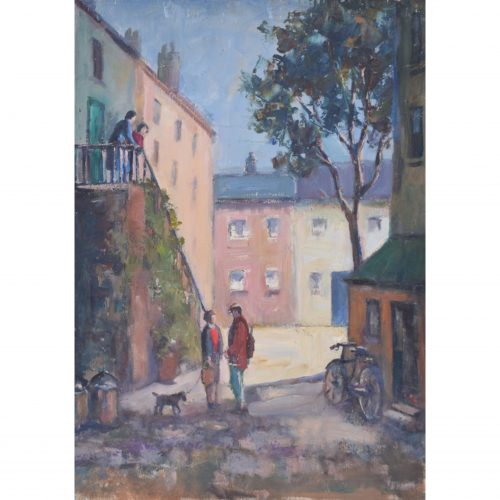
Angela Stones (1914 - 1995)
French Street Scene
Oil on board 56 x 41 cm A delightful mid-century oil painting. A couple and their dog meander down a cobbled French lane under a bright blue sky. Stones was educated at the Chelsea School of Art, and was a member of an artistic dynasty. Her mother Dorothy Bradshaw (1893-1983) studied under Jack Merriott – the artist famous for his British Rail posters, and her son, Christopher Assheton-Stones (1947-1999), was arguably the foremost pastel artist of his time. Provenance: the family of the artist. Condition: very good. If you’d like to know more, please email info@manningfineart.co.uk or call us on 07929 749056. -
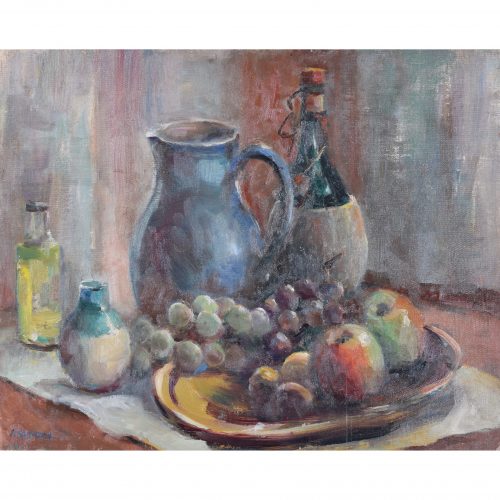
Angela Stones (1914 - 1995)
Still Life with Fruit and Jug
Oil on board 40 x 50 cm Signed lower left. A stylish mid-century still life, characterised by Stones' lively brushwork and rich use of colour. Stones was educated at the Chelsea School of Art, and was a member of an artistic dynasty. Her mother Dorothy Bradshaw (1893-1983) studied under Jack Merriott – the artist famous for his British Rail posters, and her son, Christopher Assheton-Stones (1947-1999), was arguably the foremost pastel artist of his time. Provenance: the family of the artist. Condition: very good. If you’d like to know more, please email info@manningfineart.co.uk or call us on 07929 749056. -
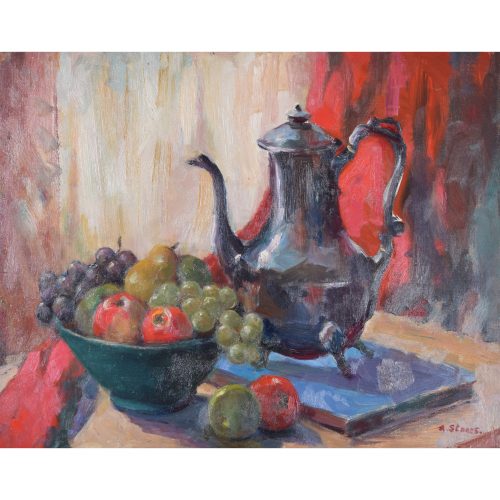
Angela Stones (1914 - 1995)
Still Life with Fruit and Coffee Pot
Oil on board 41 x 51 cm Signed lower right. A sophisticated mid-century still life, characterised by gleaming coffee pot and brimming fruit bowl. The rich red of the apples communicates with the scarlet of the draperies and Stones' signature, just as the bluish-purple hues of the grapes do with the glinting metal of the coffee pot and the blue book on which it stands. Stones was educated at the Chelsea School of Art, and was a member of an artistic dynasty. Her mother Dorothy Bradshaw (1893-1983) studied under Jack Merriott – the artist famous for his British Rail posters, and her son, Christopher Assheton-Stones (1947-1999), was arguably the foremost pastel artist of his time. Provenance: the family of the artist. Condition: very good. If you’d like to know more, please email info@manningfineart.co.uk or call us on 07929 749056. -
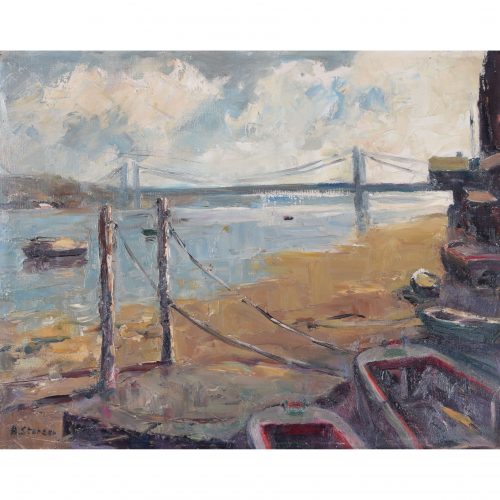
Angela Stones (1914 - 1995)
From Battersea Bridge (before Redevelopment)
Oil on board 40 x 50 cm Stones' view of the Thames and Chelsea Bridge, painted from Battersea Bridge. The artist's use of impasto, particularly evident in her depiction of the rambunctious white clouds above the bridge, lends a liveliness to the painting. Stones was educated at the Chelsea School of Art, and was a member of an artistic dynasty. Her mother Dorothy Bradshaw (1893-1983) studied under Jack Merriott – the artist famous for his British Rail posters, and her son, Christopher Assheton-Stones (1947-1999), was arguably the foremost pastel artist of his time. Provenance: the family of the artist. Condition: very good. If you’d like to know more, please email info@manningfineart.co.uk or call us on 07929 749056. -
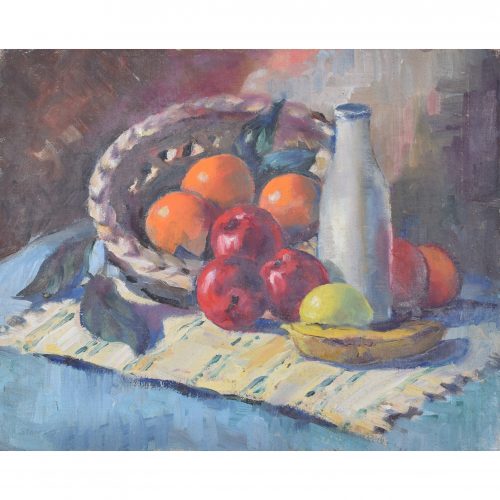
Angela Stones (1914 - 1995)
Still Life with Fruit and Milk Bottle
Oil on board 41 x 51 cm Signed lower left. A mid-century still life in oils, characterised by Stones' textured brushwork and use of vivid colours. Stones was educated at the Chelsea School of Art, and was a member of an artistic dynasty. Her mother Dorothy Bradshaw (1893-1983) studied under Jack Merriott – the artist famous for his British Rail posters, and her son, Christopher Assheton-Stones (1947-1999), was arguably the foremost pastel artist of his time. Provenance: the family of the artist. Condition: very good. If you’d like to know more, please email info@manningfineart.co.uk or call us on 07929 749056. -
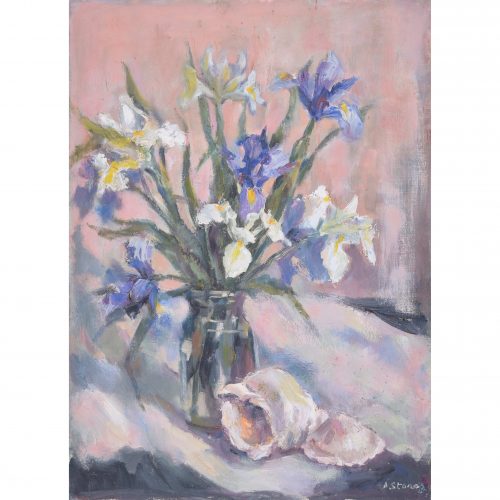
Angela Stones (1914 - 1995)
Irises
Oil on board 56 x 41 cm Signed lower right. A glass jar of irises, with two shells, on a pale pink and peach backdrop. Stones'' impasto technique brings texture to the shells and petals, and shades of purple offset the greens and pinks of the composition. Stones was educated at the Chelsea School of Art, and was a member of an artistic dynasty. Her mother Dorothy Bradshaw (1893-1983) studied under Jack Merriott – the artist famous for his British Rail posters, and her son, Christopher Assheton-Stones (1947-1999), was arguably the foremost pastel artist of his time. Provenance: the family of the artist. Condition: very good. If you’d like to know more, please email info@manningfineart.co.uk or call us on 07929 749056. -
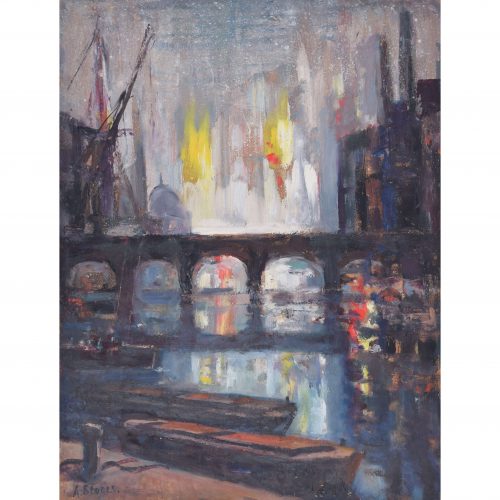
Angela Stones (1914 - 1995)
Old London Bridge Fantasia (1968)
Oil on board 56 x 43 cm Signed lower left. A fantasia inspired by Old London Bridge on the Thames. The grey dome of St Paul's peeps over the bridge; bright lights burn in the background, throwing yellows and red reflections onto the water. Moored boats bob gently in the foreground. Stones was educated at the Chelsea School of Art, and was a member of an artistic dynasty. Her mother Dorothy Bradshaw (1893-1983) studied under Jack Merriott – the artist famous for his British Rail posters, and her son, Christopher Assheton-Stones (1947-1999), was arguably the foremost pastel artist of his time. Provenance: the family of the artist. Condition: very good. If you’d like to know more, please email info@manningfineart.co.uk or call us on 07929 749056. -
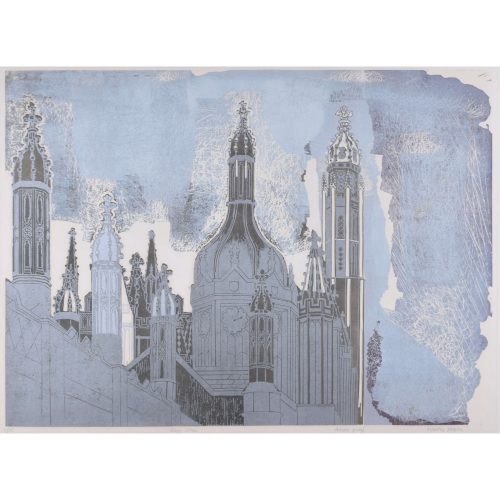
Walter Hoyle (1922 - 2000)
King's College, Cambridge (Cambridge Series 1956 - 66)
Linocut 61 x 80 cm Numbered 37/75 lower left, titled below, marked as artist's proof, and signed lower right, all in pencil. A blue- and grey-hued linocut of King's. A version of this print, owned by the Government Art Collection, hangs in the British Embassy in Tunis. Hoyle trained at Beckenham School of Art and the Royal College of Art. At the latter he was strongly influenced by Edward Bawden, one of Britain’s greatest linocut printers. Bawden had been commissioned by the 1951 Festival of Britain to produce a mural for the South Bank, and chose Hoyle to assist on account of his great talent. Hoyle moved to Great Bardfield in Essex, becoming a part of the Great Bardfield group of artists; diverse in style, they created figurative work, in stark contrast to the abstract art of the St Ives artists at the opposite end of the country. Hoyle taught at St Martin’s School of Art from 1951-60, the Central School of Arts and Crafts from 1960-64, and the Cambridge School of Art from 1964-1985, during which time he launched Cambridge Print Editions. His work is held in the collections of the Tate Gallery, the Victoria and Albert Museum, The British Museum, Kettle’s Garden and the Fry Art Gallery. Provenance: ex the Arthur Andersen collection. Condition: generally very good; some gentle and even age toning to paper. If you are interested, please email info@manningfineart.co.uk or call us on 07929 749056. Click here for other views of King's College, Cambridge. -
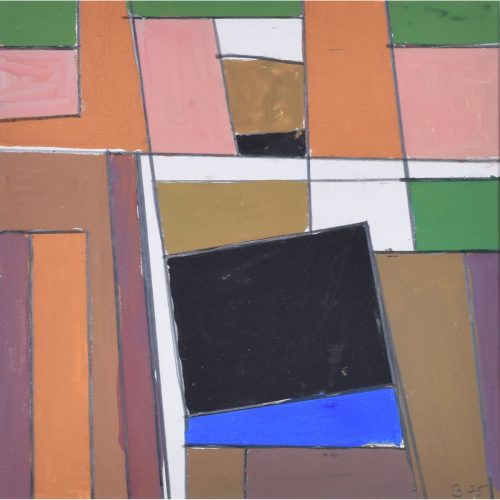
John Barnicoat MA ARCA (1924 - 2013) Harbour (1975)
Tempera on card 26 x 26 cm Initialled B and dated '75. John Barnicoat was a painter of oils and works on paper using tempera, conté, acrylic, pen, and ink. He was brought up in Cornwall and educated at King’s College, Taunton. He joined the Royal Naval Volunteer Reserves and took part in D-Day, aged 29. He went on to read history at Lincoln College, Oxford, and also studied at the Ruskin School of Drawing. He attended the Royal College of Art in the early 1950s, eventually becoming the Senior Tutor at the RCA Painting School between 1976 and 1980. He was the head of Falmouth School of Art 1972 - 1976 and Head of the Chelsea School of Art 1980 - 1989. He wrote 'Posters: a Concise History' in 1972, and organised and curated exhibitions in the UK and Russia on the art of poster design. From 1989 onwards he produced numerous drawings and oils of the bridges of London, women’s heads, acrylic and conté works on paper, and pen and wash drawings of women dressing. His work is represented in both government and private collections, and was recently shown at The Belgrave Gallery, St Ives (2017 - 2022). Provenance: the artist's estate. Condition: generally very good; in hand-finished frame. If you are interested, please email info@manningfineart.co.uk or call us on 07929 749056. Click here for other Modern British original paintings. -
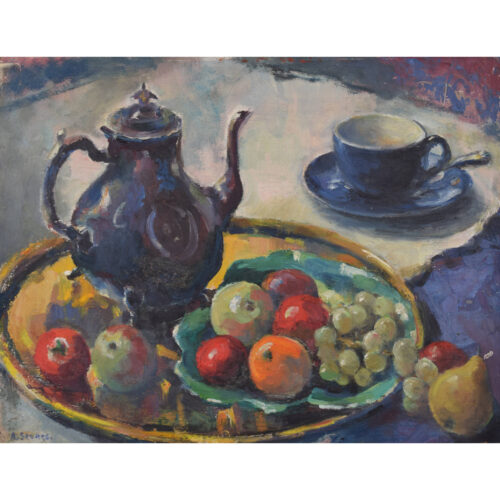
Angela Stones (1914 - 1995)
Still Life with Coffee Pot and Fruit
Oil on board 41 x 51 cm Signed lower right. Provenance: the family of the artist. A mid-century still life in oils, characterised by Stones' textured brushwork, inventive composition, and rich use of colour. Stones was educated at the Chelsea School of Art, and was a member of an artistic dynasty. Her mother Dorothy Bradshaw (1893-1983) studied under Jack Merriott – the artist famous for his British Rail posters, and her son, Christopher Assheton-Stones (1947-1999), was arguably the foremost pastel artist of his time. Condition: very good. If you’d like to know more, please email info@manningfineart.co.uk or call us on 07929 749056. Click here for more still lifes. -
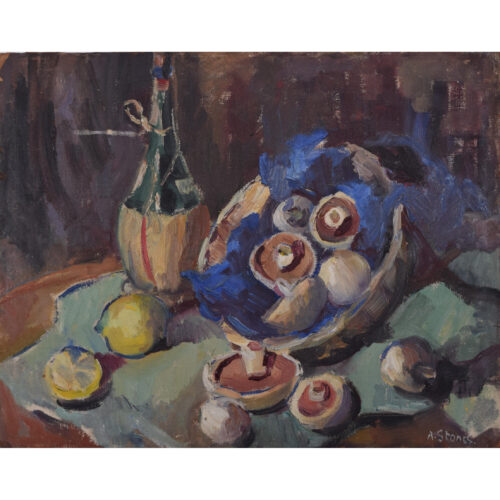
Angela Stones (1914 - 1995)
Still Life with Mushrooms
Oil on board 41 x 51 cm Signed lower right. Provenance: the family of the artist. A dark, characterful mid-century still life in oils, characterised by Stones' textured brushwork and rich use of colour. Stones was educated at the Chelsea School of Art, and was a member of an artistic dynasty. Her mother Dorothy Bradshaw (1893-1983) studied under Jack Merriott – the artist famous for his British Rail posters, and her son, Christopher Assheton-Stones (1947 - 1999), was arguably the foremost pastel artist of his time. Condition: very good. If you’d like to know more, please email info@manningfineart.co.uk or call us on 07929 749056. Click here for more still lifes. -
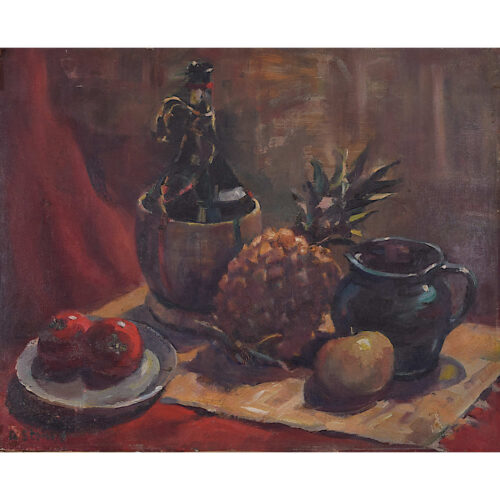
Angela Stones (1914 - 1995)
Still Life with Pineapple
Oil on board 41 x 51 cm Signed lower left. Provenance: the family of the artist. A dark, characterful mid-century still life in oils, characterised by Stones' textured brushwork and rich use of colour. Stones was educated at the Chelsea School of Art, and was a member of an artistic dynasty. Her mother Dorothy Bradshaw (1893-1983) studied under Jack Merriott – the artist famous for his British Rail posters, and her son, Christopher Assheton-Stones (1947 - 1999), was arguably the foremost pastel artist of his time. Condition: very good. If you’d like to know more, please email info@manningfineart.co.uk or call us on 07929 749056. Click here for more still lifes. -
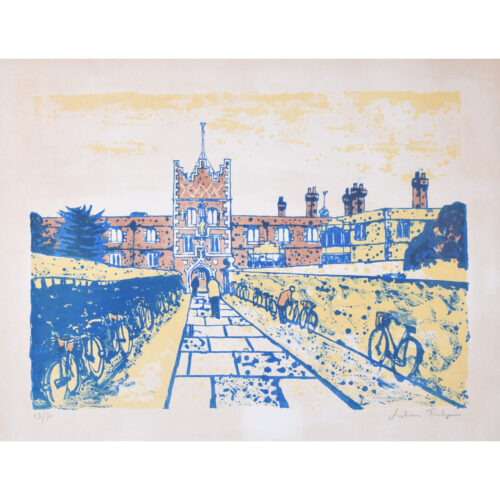
Julian Trevelyan (1910 - 1988)
Jesus College, Cambridge
Lithograph 38 x 53 cm Numbered 13/70 lower left and signed lower right, both in pencil. Nephew of the historian G M Trevelyan, Julian Trevelyan was educated at Bedales and then at Trinity College, Cambridge, where he read English. After moving to Paris, Trevelyan studied engraving at Stanley William Hayter’s school, working alongside artists such as Max Ernst, Joan Miro and Pablo Picasso. He married the potter Ursula Darwin in 1934, and in 1935 they moved to Hammersmith, buying Durham Wharf beside the River Thames which was Trevelyan’s studio – and home – for the rest of his life. His wartime service was – like so many artists – as a camoufleur. A Royal Engineer from 1940-43, he served in North Africa and Palestine, forcing the German Afrika Korps to use resources against a dummy army whilst real tanks were disguised as more harmless equipment. In the desert, nothing could be hidden - but it could be disguised. Following the dissolution of his marriage in 1950, he married the painter Mary Fedden. Teaching at Chelsea School of Art, Trevelyan eventually became head of the Etching Department and his pupils included David Hockney and Peter Ackroyd. Condition: generally very good; some age toning to paper. If you are interested, please email info@manningfineart.co.uk or call us on 07929 749056. Click here for other views of Jesus College, Cambridge. -
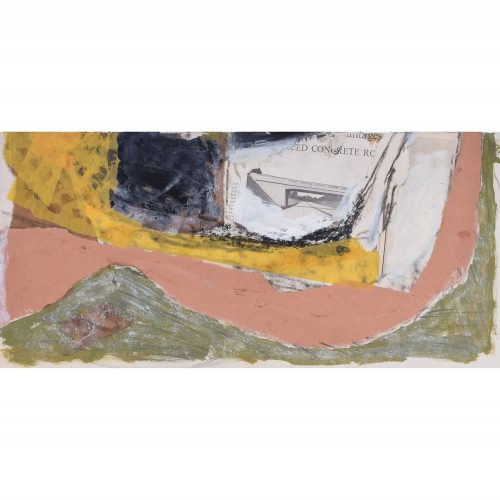
Clifford Ellis (1907-1985)
Collage II
Collage 16x37cm Provenance: the family of the artist, by descent. During his time at Bath, Ellis employed many of the leading artists of the time to teach a day or two here and there. This collage has clear suggestions of influence from Peter Lanyon. In what is clearly a landscape, the collaged includes an image of a bridge from the new M1 motorway (freeway) tearing out the heart of the countryside. Click here for biographical details and other works by the artist If you are interested email info@manningfineart.co.uk or call us on 07929 749056. -
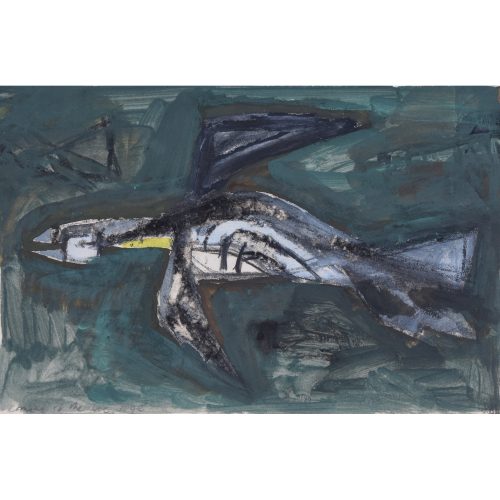
Clifford Ellis (1907-1985)
Coming of the Ice Age IV
Watercolour and crayon 23x36cm Inscribed lower left For the artist's biographical details and to see the other three designs from this series available for sale please click here. If you are interested email info@manningfineart.co.uk or call us on 07929 749056. -
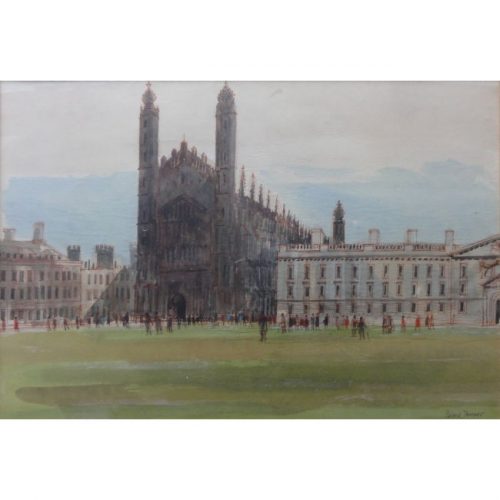 Robert Tavener (1920 – 2004) King’s College, Cambridge Signed in pen lower right, titled verso 10 1/2 x 15 Watercolour and ink 27x38cm (10.6×14.9 inches) unframed Renowned print-maker Robert Tavener was born in London. After the war he was educated at the Hornsey College of Art, and became head of print-making at Eastbourne College of Art and Design in 1953. His work is held in over twenty-five public collections, including the Government Art Collection and the V&A. Here, in a rare watercolour, he shows his skill extended well beyond print making. For other works by Robert Tavener and biographical details click here. If you are interested email info@manningfineart.co.uk or call us on 07929 749056.
Robert Tavener (1920 – 2004) King’s College, Cambridge Signed in pen lower right, titled verso 10 1/2 x 15 Watercolour and ink 27x38cm (10.6×14.9 inches) unframed Renowned print-maker Robert Tavener was born in London. After the war he was educated at the Hornsey College of Art, and became head of print-making at Eastbourne College of Art and Design in 1953. His work is held in over twenty-five public collections, including the Government Art Collection and the V&A. Here, in a rare watercolour, he shows his skill extended well beyond print making. For other works by Robert Tavener and biographical details click here. If you are interested email info@manningfineart.co.uk or call us on 07929 749056. -
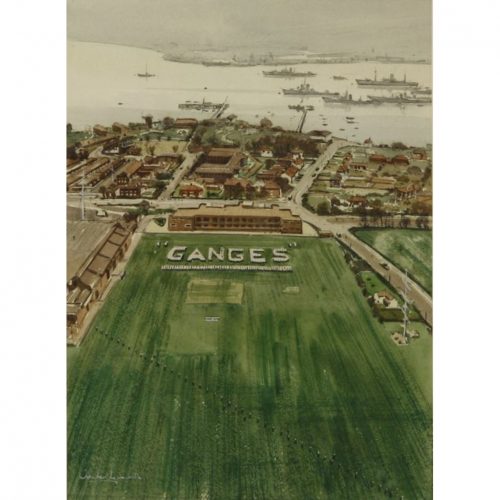
Claude Muncaster (1903-1974)
HMS Ganges near Harwich as seen from a Naval Helicopter
Watercolour with touches of gouache over pencil traces 41x31cm Signed Titled and dated 1956 to reverse HMS Ganges was a shore training establishment of the British Royal Navy. A group of ratings is spelling out the word "Ganges" as a further group are lined across the field. To the right may be seen the artificial mast that cadets learned to climb. In the sea beyond stand warships and other vessels. Muncaster was particularly keen on helicopters for obtaining an alternative view of a scene Click here for biographical details and other works by the artist. If you are interested, email info@manningfineart.co.uk or call us on 07929 749056. -
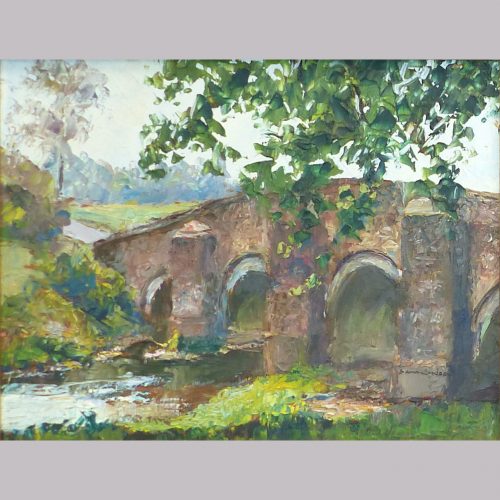
Piero Sansalvadore (1892-1955)
Chithurst Bridge Surrey
Signed Sansalvadore. Titled to verso. Oil on wood panel 21.5 x 28cm (8.5 x 11 in) Provenance: Stacy-Marks Gallery, Eastbourne, c. late 1940s An Italian who arrived in London around 1930, the Museum of London and City of London have a series of pictures Sansalvadore painted of war-damaged London. Click here for other works by the artist. If you are interested email info@manningfineart.co.uk or call us on 07929 749056. -
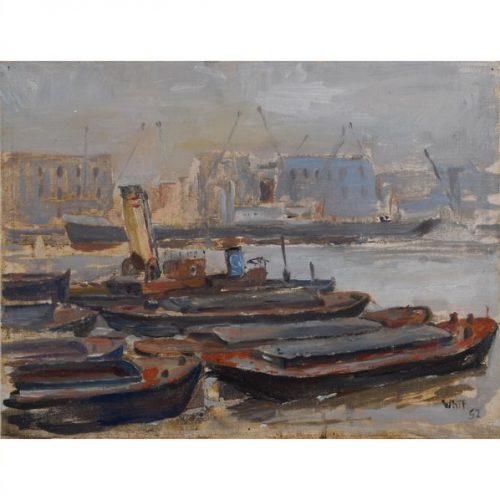
Roy M Whittenbury (fl. 1920-1955) The Pool of London
Oil on canvasboard 29 x 39.5 cm Whittenbury concentrated on marine subjects. Here he captures the Pool of London - that stretch of the River Thames from London Bridge to just below Tower Bridge which is controlled by the Port of London. Although no longer the busy port depicted in the painting, it is one of the reasons for London's political and economical pre-eminence over the last thousand years. If you are interested email info@manningfineart.co.uk or call us on 07929 749056. Condition: Good. -
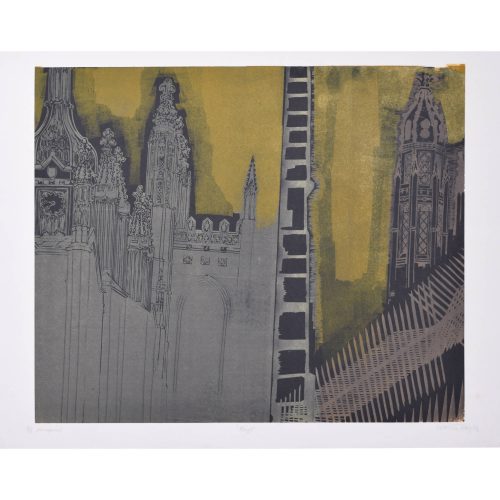
Walter Hoyle (1922 - 2000)
King's College, Cambridge (Cambridge Series 1956 - 66)
Linocut 46 x 56 cm Signed, titled, and numbered 5/5 in pencil. Hoyle's view of King's College, Cambridge, against a shadowy yellow sky. Hoyle trained at Beckenham School of Art and the Royal College of Art. At the latter he was strongly influenced by Edward Bawden, one of Britain’s greatest linocut printers. Bawden had been commissioned by the 1951 Festival of Britain to produce a mural for the South Bank, and chose Hoyle to assist on account of his great talent. Hoyle moved to Great Bardfield in Essex, becoming a part of the Great Bardfield group of artists; diverse in style, they created figurative work, in stark contrast to the abstract art of the St Ives artists at the opposite end of the country. Hoyle taught at St Martin’s School of Art from 1951-60, the Central School of Arts and Crafts from 1960-64, and the Cambridge School of Art from 1964-1985, during which time he launched Cambridge Print Editions. His work is held in the collections of the Tate Gallery, the Victoria and Albert Museum, The British Museum, Kettle’s Garden and the Fry Art Gallery. Provenance: the artist's wife. Condition: very good; few handling marks to margin, a horizontal crease about half way down that was likely in the paper prior to printing. If you are interested, please email info@manningfineart.co.uk or call us on 07929 749056. Click here for other views of King's College, Cambridge. -
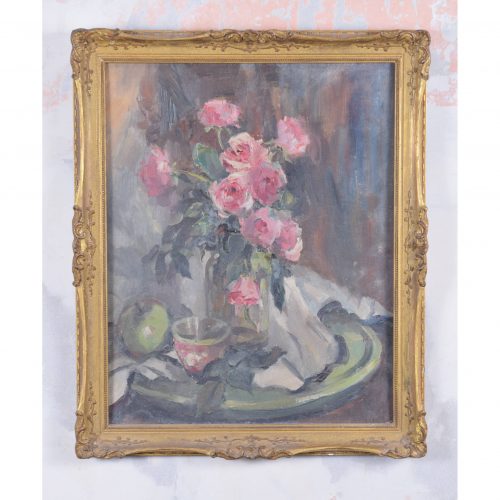
Angela Stones (1914 - 1995)
Still Life with Pink Roses
Oil on board 47 x 37 cm A beautiful still life which moves between pink and green: pink roses and bowl, and green leaves, apples, and plate. Stones' impasto technique brings texture to the fruit and petals, and the blues and browns of the background highlight the brilliance of the roses. Stones was educated at the Chelsea School of Art, and was a member of an artistic dynasty. Her mother Dorothy Bradshaw (1893 - 1983) studied under Jack Merriott – the artist famous for his British Rail posters, and her son, Christopher Assheton-Stones (1947 - 1999), was arguably the foremost pastel artist of his time. Provenance: the family of the artist. Condition: very good; gilt frame has a few repaired small losses. If you are interested, please email info@manningfineart.co.uk or call us on 07929 749056. Click here for other pictures by the artist. -
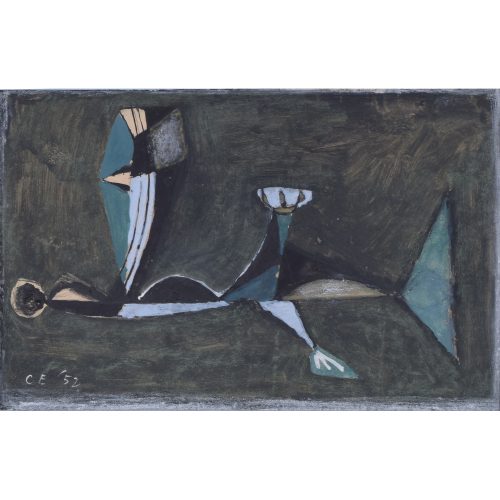
Clifford Ellis (1907-1985)
Coming of the Ice Age II
Watercolour Signed CE '52 15x24cm For the artist's biographical details and to see the other three designs from this series available for sale please click here. If you are interested email info@manningfineart.co.uk or call us on 07929 749056. -
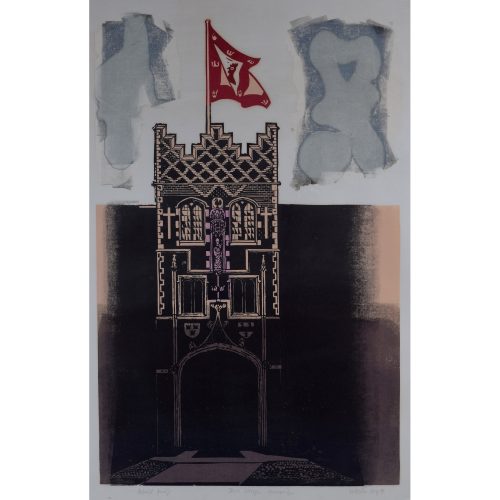
Walter Hoyle
Jesus College Cambridge
Linocut, 1965 76x48 cm Signed and titled in pencil. Printed on handmade Japanese Hosho paper by the artist at Editions Electo Click here for biographical details and other works by the artist. If you are interested email info@manningfineart.co.uk or call us on 07929 749056. -
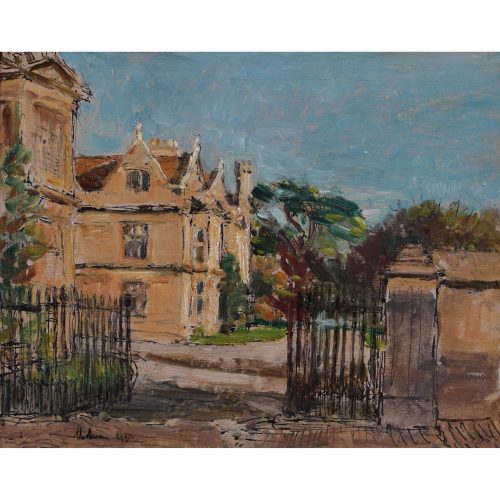
Paul Ayshford Methuen, 4th Baron Methuen of Corsham (1886 -1974)
Corsham Court
Oil on Board Signed and dated 1957 9x11 inches Corsham Court is home to the Barons Methuen. For biographical details and other works by the artist click here. If you are interested email info@manningfineart.co.uk or call us on 07929 749056. -
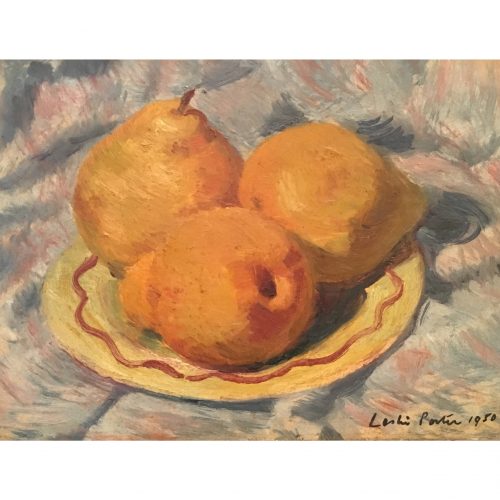
Leslie Porter (British, 1903-1977) 'Still Life with Pears'
Oil on board Signed and dated 1950 16 x 21cm Leslie was born in 1903. He trained at art school (Camberwell I recall) and had an interesting and varied career in marketing and advertising, culminating at one of the UK's largest advertising Agencies, LPE, (later Leo Burnett) where he was a board director and creative director until his retirement in the late '60s. During that time and after his retirement he was a frequent traveller to France where he produced a raft of oil paintings, sketches and pastels observing local people and the lives they led. Also many paintings of buildings and the mostly urban environment both abroad and in this country. One of his early jobs was with London Transport where he produced posters and other publicity material, some of which is in the V&A - you can see a couple online with a bit of an online search. His work was displayed at several exhibitions in London and he was awarded prizes for his oil paintings in France. After his retirement he moved to the coast at Folkestone where he continued to paint - subjects and buildings around the town, festivals, people and occasional visits across the Channel to France. He was married but later divorced and lived with his partner Dorothy until his death in Folkestone in 1977. If you are interested email info@manningfineart.co.uk or call us on 07929 749056. Condition: Excellent. In a hand-finished oak frame. -
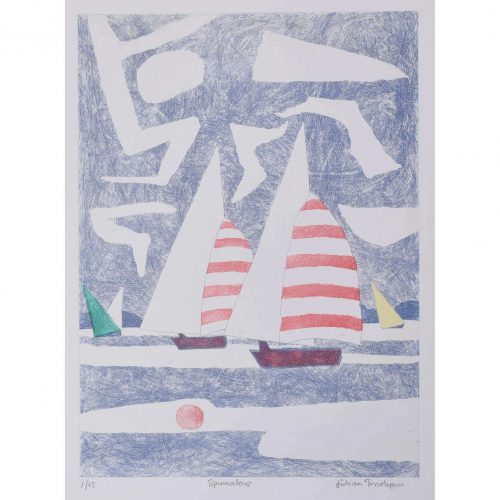
Julian Trevelyan (1910-1988)
Spinnakers (1972)
Etching 48 x 35 cm (sheet size 68 x 55 cm) Signed in pencil and numbered 1/65. The Tate holds number 24/56 - reference P01330. Small vessels weave around two great boats with striped masts, observed by a dark sky full of geometric clouds. A red buoy bobs in the foreground, and the heavily textured sea and sky blend into one. Nephew of the historian G M Trevelyan, Julian Trevelyan was educated at Bedales and then at Trinity College, Cambridge, where he read English. After moving to Paris, Trevelyan studied engraving at Stanley William Hayter’s school, working alongside artists such as Max Ernst, Joan Miro and Pablo Picasso. He married the potter Ursula Darwin in 1934, and in 1935 they moved to Hammersmith, buying Durham Wharf beside the River Thames which was Trevelyan’s studio – and home – for the rest of his life. His wartime service was – like so many artists – as a camoufleur. A Royal Engineer from 1940-43, he served in North Africa and Palestine, forcing the German Afrika Korps to use resources against a dummy army whilst real tanks were disguised as more harmless equipment. In the desert, nothing could be hidden - but it could be disguised. Following the dissolution of his marriage in 1950, he married the painter Mary Fedden. Teaching at Chelsea School of Art, Trevelyan eventually became head of the Etching Department and his pupils included David Hockney and Peter Ackroyd. Condition: generally very good. Mounted to board. If you’d like to know more, please email info@manningfineart.co.uk or call us on 07929 749056. -
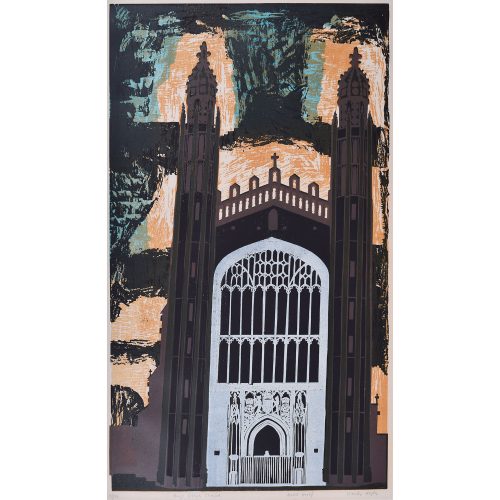
Walter Hoyle (1922 - 2000)
King's College Chapel West End, Cambridge (1965)
Linocut Cambridge Series 51/75, Signed and Titled. Printed by the artist at Editions Alecto71x41cm Click here for biographical details and other works by the artist. If you are interested email info@manningfineart.co.ukor call us on 07929 749056. -
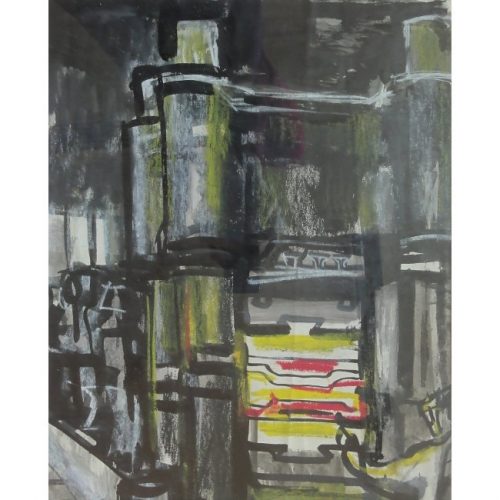
David Smith RE (1920-1999)
Sulzer Engineering Works Switzerland II
Mixed media 40x33cm Please note we have two works in this series which are available, click here for the other. Framed in a grey wood frame. Born in Lowestoft he served in Bomber Command during the war and was commissioned to sketch on bombing raids over Germany. After the war, he taught at Chelsea School of Art and Camden Arts Centre. His biggest commissions were for Trinity House, recording Lighthouses, and Sulzer Engineering in Switzerland. If you are interested email info@manningfineart.co.uk or call us on 07929 749056. -
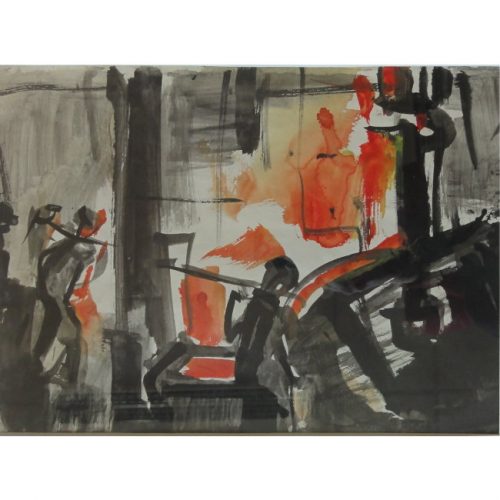 David Smith RE (1920-1999) Sulzer Engineering Works Switzerland Watercolour 26×36.5cm Please note we have two works in this series, click here for the other one. Here abstract, modernist figures filled with energy, hinting towards perhaps Epstein-like characteristics, are illuminated by the forge providing a splash of colour. Born in Lowestoft he served in Bomber Command during the war and was commissioned to sketch on bombing raids over Germany. After the war, he taught at Chelsea School of Art and Camden Arts Centre. His biggest commissions were for Trinity House, recording Lighthouses, and Sulzer Engineering in Switzerland. If you are interested email info@manningfineart.co.uk or call us on 07929 749056.
David Smith RE (1920-1999) Sulzer Engineering Works Switzerland Watercolour 26×36.5cm Please note we have two works in this series, click here for the other one. Here abstract, modernist figures filled with energy, hinting towards perhaps Epstein-like characteristics, are illuminated by the forge providing a splash of colour. Born in Lowestoft he served in Bomber Command during the war and was commissioned to sketch on bombing raids over Germany. After the war, he taught at Chelsea School of Art and Camden Arts Centre. His biggest commissions were for Trinity House, recording Lighthouses, and Sulzer Engineering in Switzerland. If you are interested email info@manningfineart.co.uk or call us on 07929 749056. -
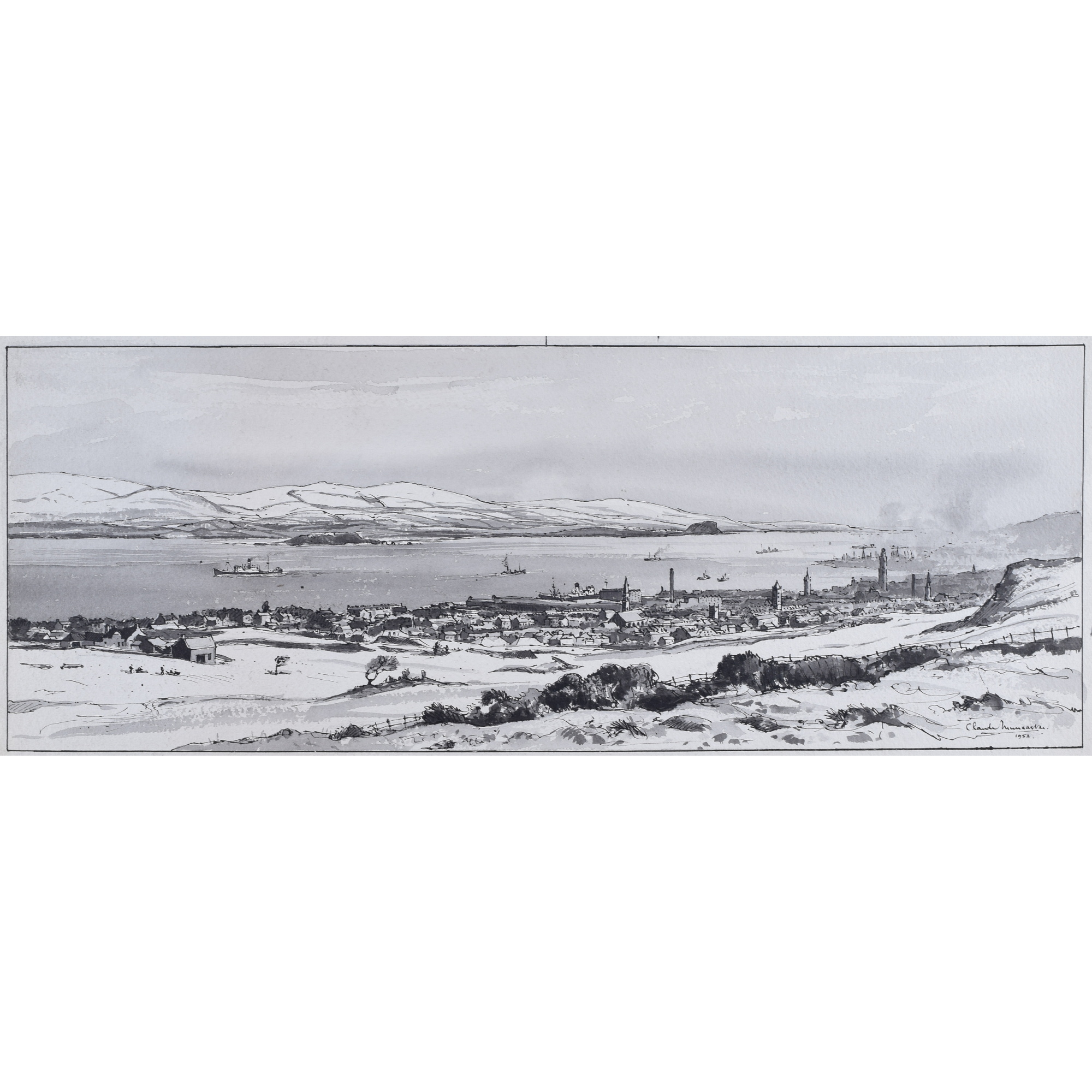
Claude Muncaster (1903-1974)
View of the Clyde from Lyle Hill
Monochrome watercolour with ink Signed and dated 1952, and inscribed 'Sphere' 18x50cm DRAWN FOR 'THE SPHERE' ILLUSTRATED MAGAZINE Click here for biographical details and other works by the artist. If you are interested email info@manningfineart.co.uk or call us on 07929 749056. -
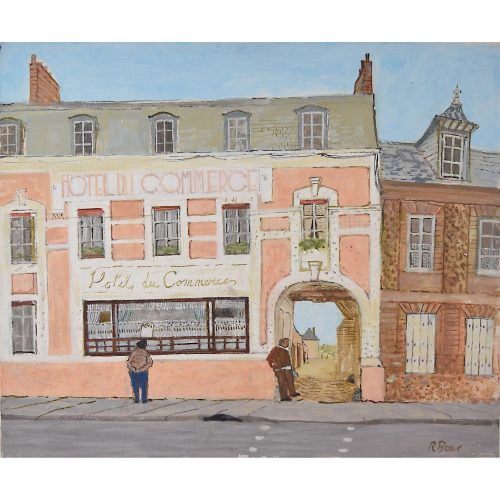
Richard Beer (1928-2017)
Hotel du Commerce, France
Oil painting 51x60 cm Click here for biography and other works by this artist. If you are interested email info@manningfineart.co.uk or call us on 07929 749056. -
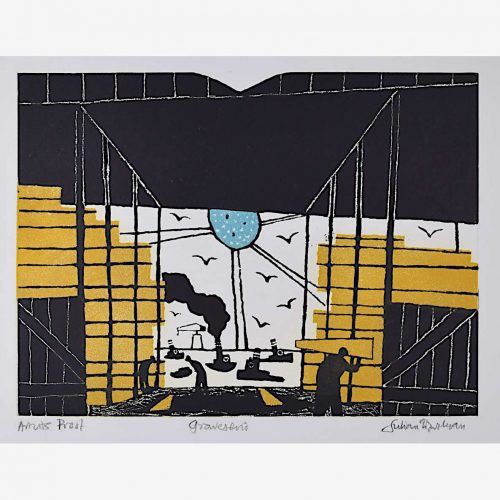
Julian Trevelyan (1910-1988)
Gravesend (1969)
Etching and aquatint, signed, titled, and inscribed 'Artist's Proof' in pencil 35x48cm (sheet size 59x77cm) On J Green paper Condition: generally excellent, never previously framed, see image. Click here for biographical details and other works by the artist. If you are interested email info@manningfineart.co.uk or call us on 07929 749056. -
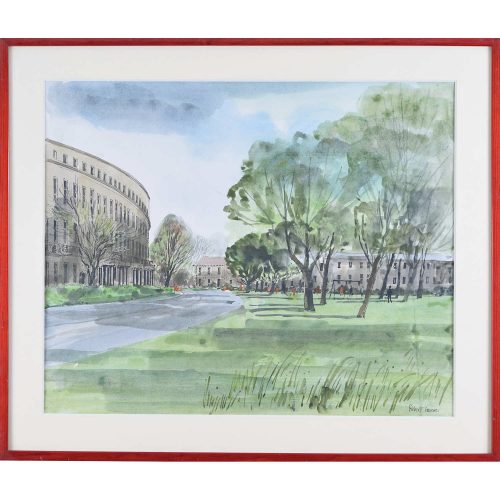
Robert Tavener (1920 - 2004)
Lansdown Parade, Cheltenham
Watercolour and pen 38 x 46 cm Signed lower right. The thin watercolour wash of the lawns and the fine ink pen expression of the college's architecture create a contrast between the natural and the man-made in this picture by Tavener. He painted several views of the city of Cheltenham and its architectural landmarks, including of Cheltenham College (this picture is available here). Condition: generally very good. -
Out of stock
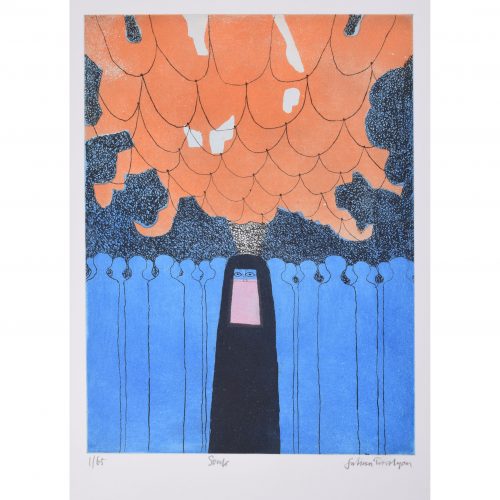
Julian Trevelyan (1910 - 1988)
Souk (1972)
Etching and aquatint 71 x 56 cm Signed, titled, and numbered 1/65 in pencil outside of the plate. The Tate Collection holds number 25/65. An Arab bazaar. Tall, nameless blue figures surround a veiled and staring woman. Nephew of the historian G M Trevelyan, Julian Trevelyan was educated at Bedales and then at Trinity College, Cambridge, where he read English. After moving to Paris, Trevelyan studied engraving at Stanley William Hayter’s school, working alongside artists such as Max Ernst, Joan Miro and Pablo Picasso. He married the potter Ursula Darwin in 1934, and in 1935 they moved to Hammersmith, buying Durham Wharf beside the River Thames which was Trevelyan’s studio – and home – for the rest of his life. His wartime service was – like so many artists – as a camoufleur. A Royal Engineer from 1940-43, he served in North Africa and Palestine, forcing the German Afrika Korps to use resources against a dummy army whilst real tanks were disguised as more harmless equipment. In the desert, nothing could be hidden - but it could be disguised. Following the dissolution of his marriage in 1950, he married the painter Mary Fedden. Teaching at Chelsea School of Art, Trevelyan eventually became head of the Etching Department and his pupils included David Hockney and Peter Ackroyd. Condition: mounted to board, small scuff to very bottom of margin, otherwise very good. If you’d like to know more, please email info@manningfineart.co.uk or call us on 07929 749056. -

Walter Hoyle (1922 - 2000)
Emmanuel College, Cambridge (Cambridge Series 1956 - 66)
Linocut 55 x 43 cm Signed and inscribed A/P in pencil. Hoyle's view of Emmanuel's Front Court bleaches the gold of the chapel's Ketton Stone into an icy blue, and situates it beneath a tempestuous yellow sky. Hoyle trained at Beckenham School of Art and the Royal College of Art. At the latter he was strongly influenced by Edward Bawden, one of Britain’s greatest linocut printers. Bawden had been commissioned by the 1951 Festival of Britain to produce a mural for the South Bank, and chose Hoyle to assist on account of his great talent. Hoyle moved to Great Bardfield in Essex, becoming a part of the Great Bardfield group of artists; diverse in style, they created figurative work, in stark contrast to the abstract art of the St Ives artists at the opposite end of the country. Hoyle taught at St Martin’s School of Art from 1951-60, the Central School of Arts and Crafts from 1960-64, and the Cambridge School of Art from 1964-1985, during which time he launched Cambridge Print Editions. His work is held in the collections of the Tate Gallery, the Victoria and Albert Museum, The British Museum, Kettle’s Garden and the Fry Art Gallery. Provenance: family of the artist. Condition: generally very good; a few handling marks and areas of discolouration to extreme margins, extraneous ink to right hand side, and a very small brown spot to very top right beyond the blue sky. If you are interested, please email info@manningfineart.co.uk or call us on 07929 749056. Click here for other views of Emmanuel College, Cambridge. -
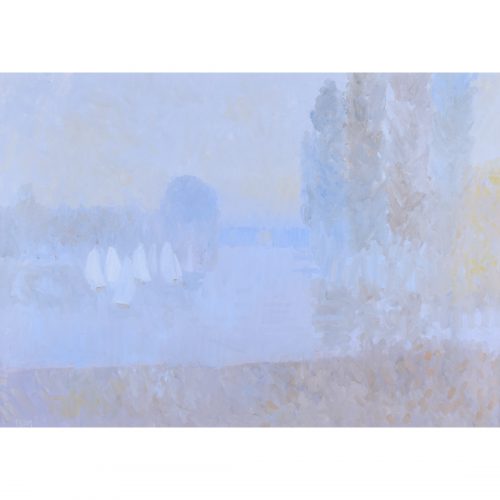
Bernard Myers (1925 - 2007)
Chiswick Reach
Oil on paper 50 x 72 cm Myers' impressionist view of Chiswick Reach (likely painted from his studio, which overlooked the Thames) depicts a hazy morning mist making its way down the river. The artist's sparse and muted palette renders the sky barely discernible from the water; chevron brushstrokes make up trees which cast their shadows over the Thames. A flotilla of boats, ghost-like with their white sails, appear from the blue mist. Bernard Myers was a painter and printmaker who trained at St Martin’s School of Art, the Camberwell School of Arts and Crafts, and the Royal College of Art in the 1940s and 1950s. This painting won the David Murray Landscape Scholarship and was painted while Myers was a student at the RCA. He went on to teach there before moving into a studio in Hammersmith. He lived and painted at 5 Durham Wharf, just off Chiswick Mall and with a view of the Thames, from the 1980s until his death in 2007. Provenance: New Grafton Gallery. Condition: excellent. If you are interested, please email info@manningfineart.co.uk or call us on 07929 749056. Click here for other views of London. -
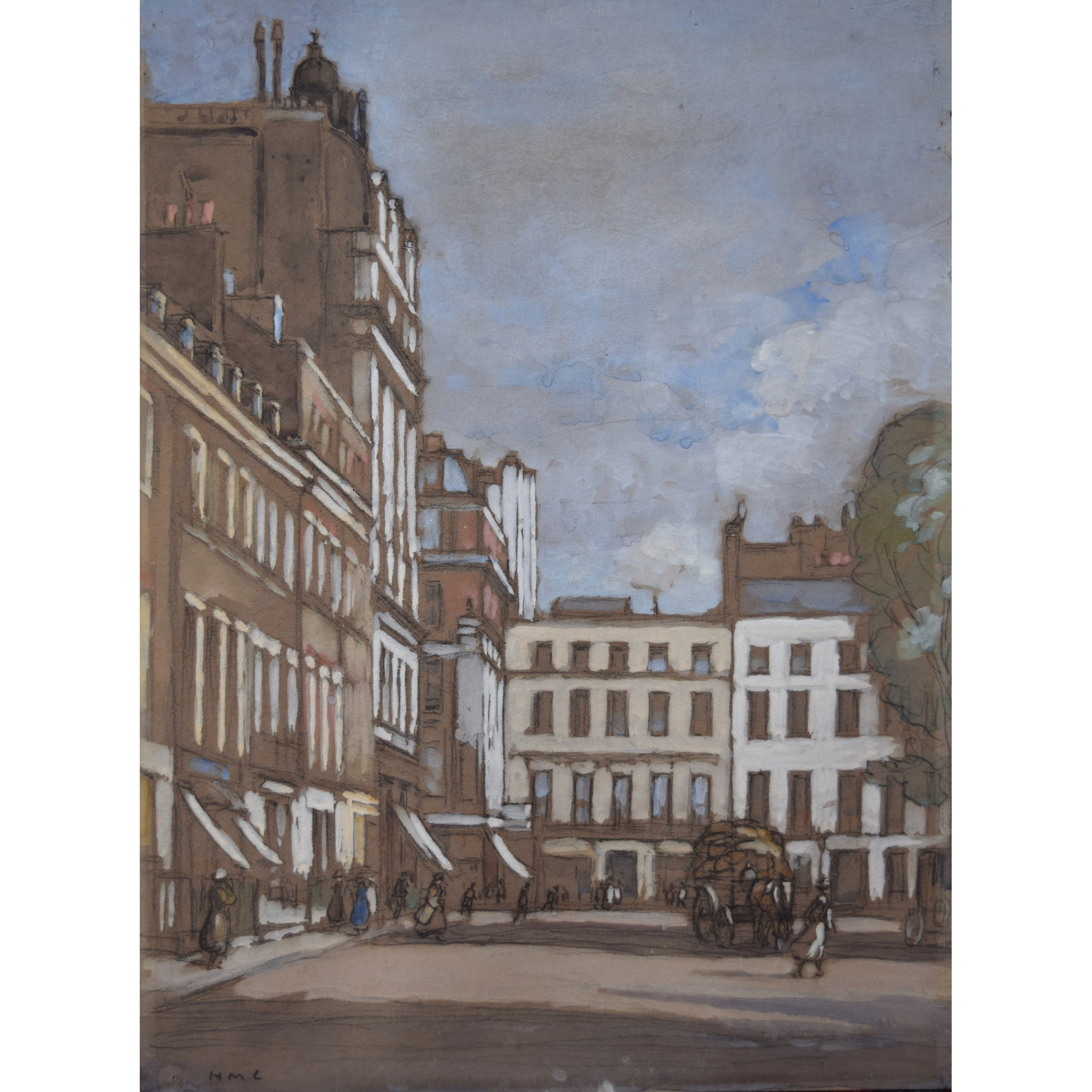
Horace Mann Livens (1862-1936)
Hanover Square London (1920)
Gouache on paper 37x27 cm For biographical details and other works by Livens click here. If you are interested email info@manningfineart.co.uk or call us on 07929 749056. -
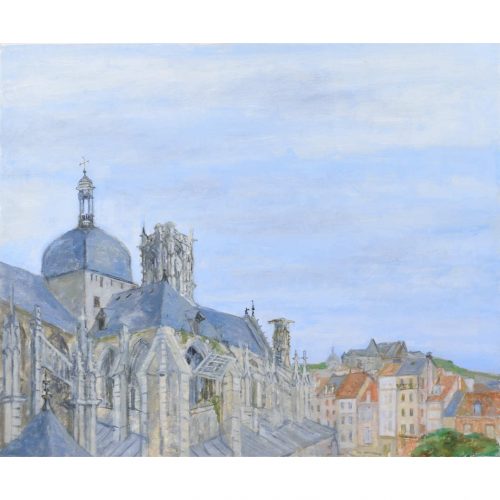
Richard Beer (1928 - 2017)
Dieppe Cathedral
Oil on canvas 66 x 76 cm A mountaintop cathedral and surrounding houses; broad blue sky fills the rest of the canvas. This oil painting is a fantastic example of Beer's focus on architecture, the central and recurring theme of his pictorial idiom. Born in London in 1928, just too late to serve in the Second World War, Richard Beer studied between 1945 - 1950 at the Slade School. Subsequently, a French Government scholarship allowed him to spend time in Paris at Atelier 17, working under Stanley William Hayter (1901 - 1988), one of the most significant print makers of the 20th Century – having spent the War in New York, advising as a camofleur, Hayter only returned to Paris in 1950. Subsequently Beer studied at the École des Beaux Arts, Paris. Working for John Cranko, choreographer for the Royal Ballet, Beer designed the sets and costumes for his The Lady and the Fool at Covent Garden, subsequently working for him following his move in 1961 to Stuttgart Ballet. Additionally he produced book illustrations and designed book jackets. Beer later taught print-making at the Chelsea School of Art, where he was a popular teacher. Probably his greatest work was a collaboration with John Betjeman to produce a portfolio of prints of ten Wren Churches in the City for Editions Alecto, copies of which are in The Government Art Collection. That collection contains a total of 54 prints by Beer, and the Tate Gallery’s collection holds seven. His Oxford series was also produced for Editions Alecto as was a series of predominantly architectural views in Southern Europe. Most of his prints are of architectural subjects. Condition: excellent. If you’d like to know more, please email info@manningfineart.co.uk or call us on 07929 749056. Click here for other views by Richard Beer. -
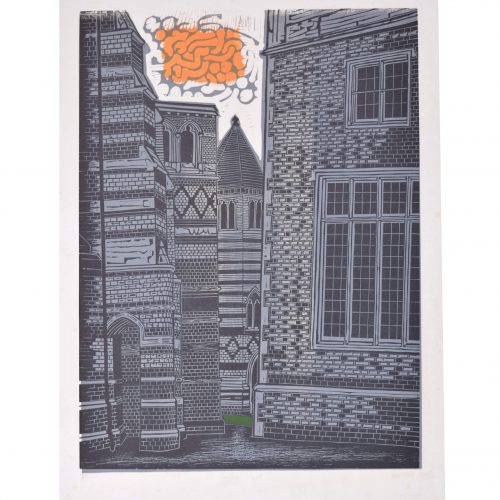
Walter Hoyle (1922 - 2000)
Rugby School
Linocut 62 x 46 cm Signed, titled, and inscribed A/P in pencil. Possibly unique. Hoyle's view of Rugby School. The school's architecture is depicted in shades of blue and grey, with an orange patch of sun in the cloudy sky above. A green garden peeks out from between the buildings, which lean gently away from one another. Hoyle trained at Beckenham School of Art and the Royal College of Art. At the latter he was strongly influenced by Edward Bawden, one of Britain’s greatest linocut printers. Bawden had been commissioned by the 1951 Festival of Britain to produce a mural for the South Bank, and chose Hoyle to assist on account of his great talent. Hoyle moved to Great Bardfield in Essex, becoming a part of the Great Bardfield group of artists; diverse in style, they created figurative work, in stark contrast to the abstract art of the St Ives artists at the opposite end of the country. Hoyle taught at St Martin’s School of Art from 1951-60, the Central School of Arts and Crafts from 1960-64, and the Cambridge School of Art from 1964-1985, during which time he launched Cambridge Print Editions. His work is held in the collections of the Tate Gallery, the Victoria and Albert Museum, The British Museum, Kettle’s Garden and the Fry Art Gallery. Condition: enerally very good; a few handling marks and a little spotting to the margins. If you are interested, please email info@manningfineart.co.uk or call us on 07929 749056. -
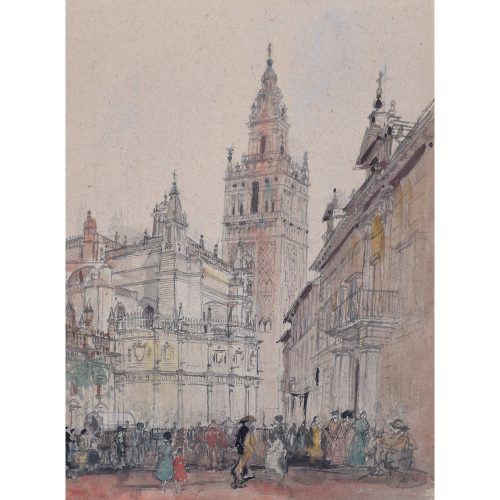
Sir Albert Edward Richardson K.C.V.O., F.R.I.B.A, F.S.A., P.R.A. (1880-1964)
La Giralda Seville
38x28cm Watercolour Sir Albert Edward Richardson K.C.V.O., F.R.I.B.A, F.S.A., P.R.A. (1880-1964) was a traditionalist, renowned for his distaste of modern architecture. Rooted firmly in the classical period, he lived a Georgian life, refusing to have electricity in his Georgian house – until his wife finally insisted. Professor of Architecture at UCL’s Bartlett School of Architecture from 1929-1955, this was evacuated to Cambridge during the war and he became a fellow of St Catharine’s College. Amongst his other achievements, Richardson was President of the RA, editor of Architect’s Journal and founder of the Georgian Group. For pleasure he painted architectural fantasies; capriccios of buildings he pictured in his mind. Richardson was recipient of the Architectural Association’s Professor Bannister Fletcher Medal in 1902 which was an award for the study of post-Fire London architecture. Amongst his achievements were Professor of Architecture at University College London, President of the RA, editor of Architect’s Journal and founder of the Georgian Group. Click here for other works by the artist and biographical details. If you are interested email info@manningfineart.co.uk or call us on 07929 749056. -
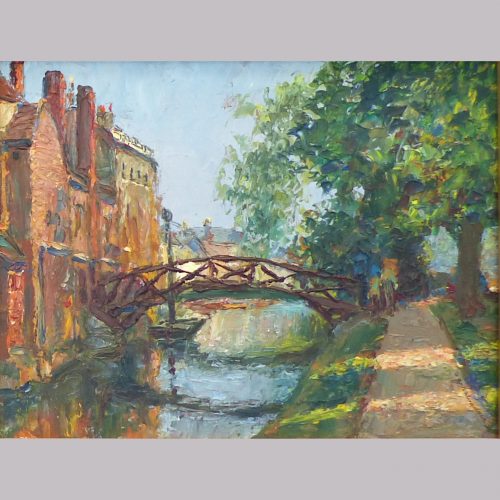
Piero Sansalvadore (1892-1955)
Queens’ College Cambridge
Signed Sansalvadore. Titled to verso. Oil on wood panel 21.5 x 28cm (8.5 x 11 in) £1850 Provenance: Stacy-Marks Gallery, Eastbourne, c. late 1940s An Italian who arrived in London around 1930, the Museum of London and City of London have a series of pictures Sansalvadore painted of war-damaged London. Click here for other works by the artist. If you are interested email info@manningfineart.co.uk or call us on 07929 749056. -
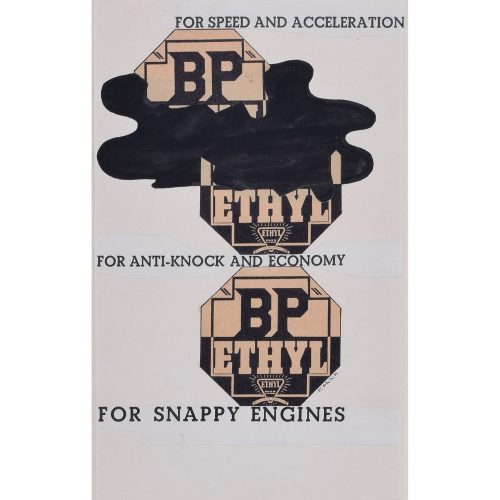
Edward McKnight Kauffer (1890-1954)
Original artwork ‘BP Ethyl for Snappy Engines' (1934)
Signed Pen, ink and collage 27x17cm (16.6×6.6 inches) Framed in a hand-finished black frame. Provenance: Sotheby's, sale of the Shell Archive 10 September 2003 lot 49. If you are interested email info@manningfineart.co.ukor call us on 07929 749056. -
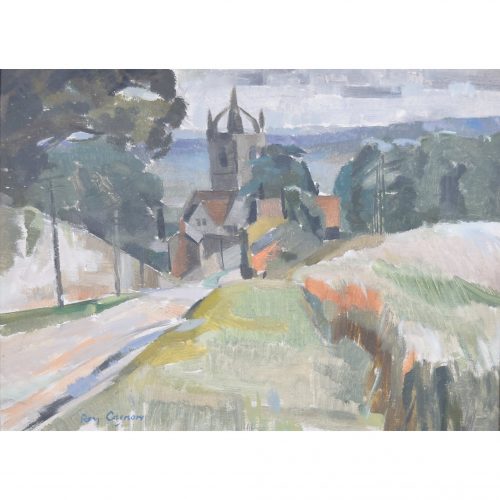
Roy Carnon (1911-2002)
All Hallows Church, Tillington, near Petworth
Oil on board 31 x 42cm Signed; in the artist's original frame Condition: excellent. Click to view biographical details and other works by the artist. Carnon attended Chiswick Art School becoming an illustrator. In 1965 he was responsible for visualising spacecraft for "2001: A Space Odyssey", being designer of the iconic 'wheel' spacestation. These drawings are now in the Kubrick archives at UAL. -
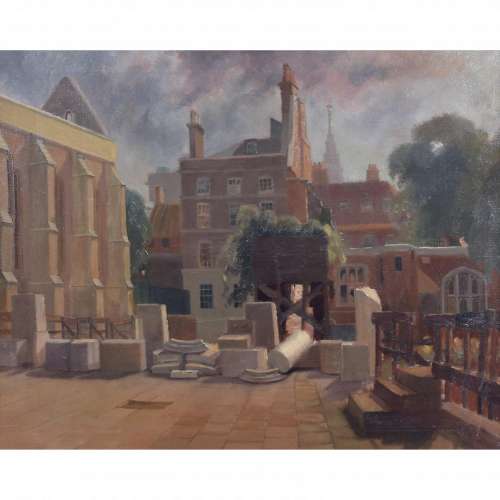
Clifford Charman (1910-1993)
Temple Church, London, after Bombing
Oil on canvas 39 x 49 cm Provenance: The Artist's Studio Sale, Bonhams, London (18 March 1993); Peter Constant Fine Art. Born in Bexleyheath in Kent, Charman studied at Regent Street Polytechnic just before, and just after, the Second World War. He exhibited widely, including at the Royal Academy, the RBA, Chelsea Arts Society, and abroad. Elected in 1954 to the ROI, he also won the James Bourlet Prize in 1982. His work is in collections including that of the Guildhall. If you'd like to know more, please email info@manningfineart.co.uk or call us on 07929 749056. Condition: Generally very good. -
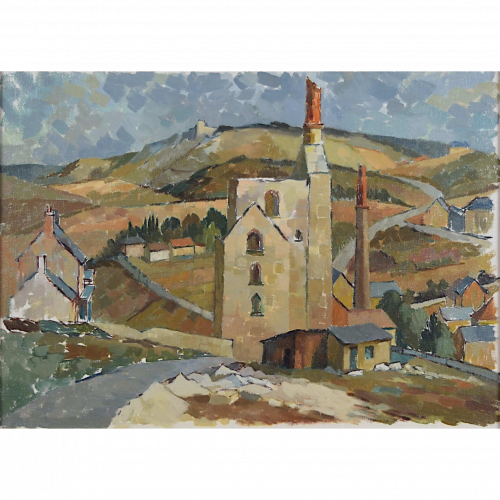
Clifford Charman (1910-1993)
Landscape with Farmhouses
Oil on canvas 38 x 55 cm Provenance: the artist's studio sale, Bonhams, London 1993. Born in Bexleyheath in Kent, Charman studied at Regent Street Polytechnic just before, and just after, the Second World War. He exhibited widely, including at the Royal Academy, the RBA, Chelsea Arts Society, and abroad. Elected in 1954 to the ROI, he also won the James Bourlet Prize in 1982. His work is in collections including that of the Guildhall. If you'd like to know more, please email info@manningfineart.co.uk or call us on 07929 749056. Condition: Generally very good. -
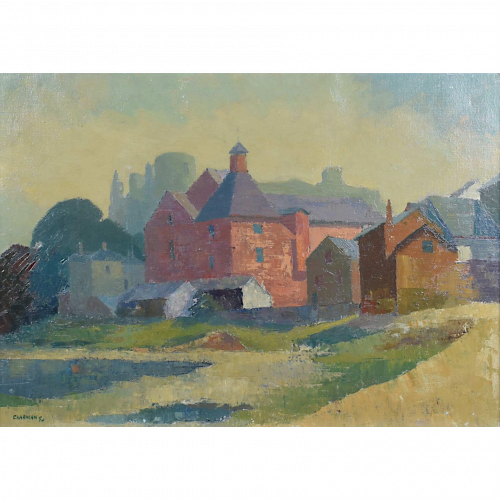
Clifford Charman (1910-1993)
Brewery and Ruined Castle, Cockermouth
Oil on canvas 38 x 55 cm Signed and dated lower left. Provenance: The Artist's Studio Sale, Bonhams, London (18 March 1993); Peter Constant Fine Art. Born in Bexleyheath in Kent, Charman studied at Regent Street Polytechnic just before, and just after, the Second World War. He exhibited widely, including at the Royal Academy, the RBA, Chelsea Arts Society, and abroad. Elected in 1954 to the ROI, he also won the James Bourlet Prize in 1982. His work is in collections including that of the Guildhall. If you'd like to know more, please email info@manningfineart.co.uk or call us on 07929 749056. Condition: Generally very good. Signed lower left. -
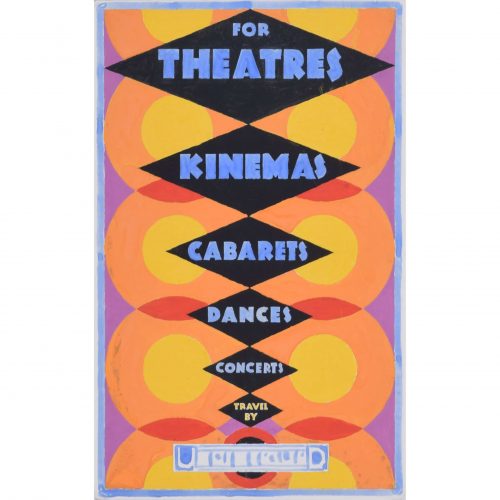
Gerald Mac Spink (flourished 1920 - 1940)
For Theatres, Kinemas, Cabarets, Dances, Concerts, Travel by Underground (c. 1930)
Gouache 30 x 19 cm Original design for a London Transport poster. Framed. A fantastic gouache design by Spink for a London Underground poster. The artist's striking Art Deco design and heady use of colour advertises the glamour of travelling by Tube to various evening entertainments around London. Spink was a skilled artist and designer who produced a series of posters in the inter-war period for companies including the London Underground, Southern Railways, LNER, Hawker Engineering, and British Steel. He won a prize in 1933 from the Imperial Institute for his poster artwork. He also worked as an aeronautical engineer in Kingston-on-Thames for Hawker Engineering; his greatest achievement was the creation of the 'Squanderbug', a 500cc racing car which he built in 1947, and which races even to this day. Provenance: the artist's estate. Condition: good; a few small scuffs to gouache, as visible in photographs. Handsomely framed. If you’d like to know more, please email info@manningfineart.co.uk or call us on 07929 749056. -
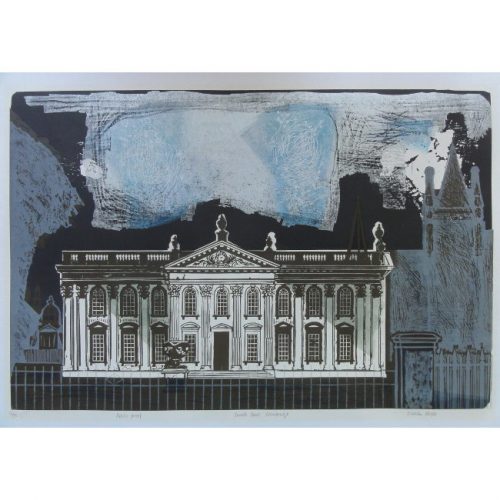
Walter Hoyle (1922-2000)
Senate House, Cambridge (Cambridge Series 1956-6)
Block print 72/75 Artist’s proof, published by Editions Alecto, London, 1966 46x89cm Click here for biographical details and other works by the artist. If you are interested email info@manningfineart.co.uk or call us on 07929 749056. -
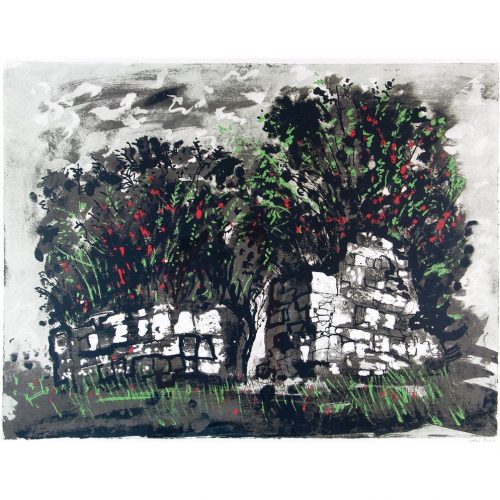
John Piper
Skeabost, Skye 1975
Screenprint by Curwen Studio Printed on Arches by Kelpra Studio and published by Marlborough Fine Art 68x89cm Signed in crayon; an un-numbered proof print aside from the edition of 70. Levinson 250 From the Series 'Five Scottish Chapels (in ruins)' If you are interested email info@manningfineart.co.uk or call us on 07929 749056. -
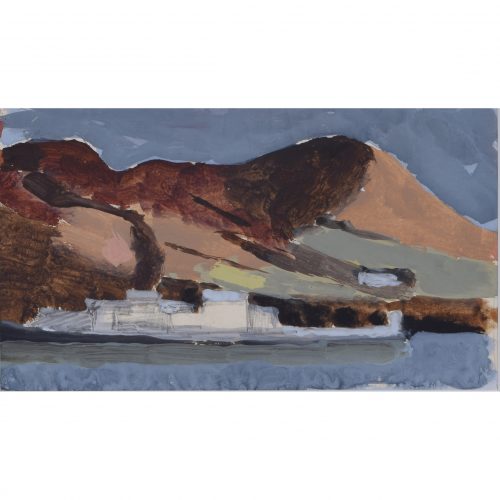
Clifford Ellis (1907-1985)
Cadbury Castle, Wiltshire
Gouache, 1940s/1950s In a Nicholson butt-jointed frame Provenance: the family of the artist, by descent. Click here for biographical details and other works by the artist. Clifford and Rosemary Ellis were famous as a husband and wife team for their fascination with nature and their vibrant and charming depictions of animals. They were the natural artists to be commissioned by Collins for their 'New Naturalists' series of books, which have become famous and highly collectable more for the dust jackets designed by the Ellises than for the - otherwise excellent - content. This painting is from a recently discovered series of paintings and drawings, never before seen by the general public, dating from the 1940s and 1950s. If you are interested email info@manningfineart.co.uk or call us on 07929 749056. -
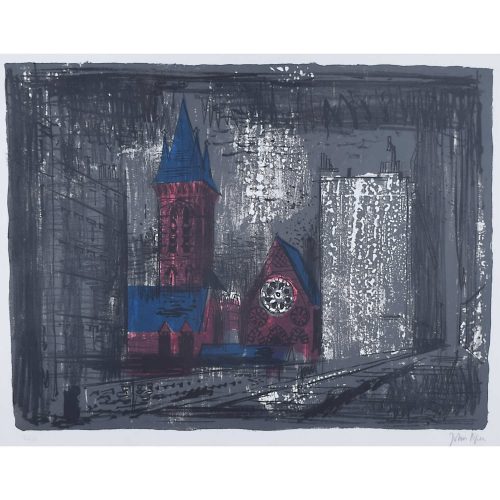
John Piper (1903-1992)
St James the Less, Westminster
Screenprint 65 x 49 cm From the 'Retrospect of Churches' series, numbered 24/70. Generally very good. Signed in pencil. John Piper CH was an English painter, printmaker, and designer of stained-glass windows. His work often focused on the British landscape, especially churches and monuments, and included tapestry designs, book jackets, screen-prints, photography, fabrics and ceramics. A Retrospect of Churches was issued as a suite of 24 original colour lithographs in colour, in an edition of 70 copies (70 numbered copies plus five artist's proofs). This poignant and dramatic representation of St James the Less is an evocative depiction of this part of London in the evening: wet pavements reflect the bright lights of the buildings, and the church is a warm, moody reddish-purple against the deep black of a dark night. Condition: Generally very good. -
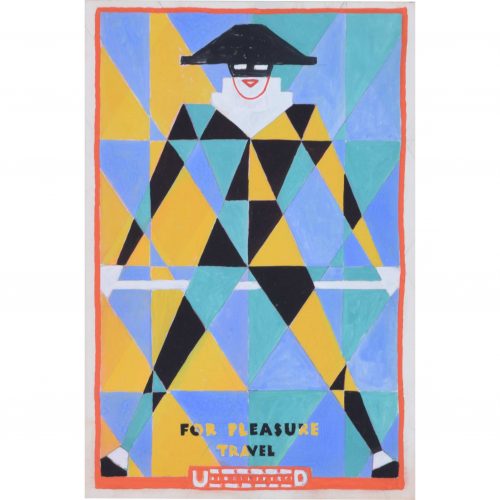
Gerald Mac Spink (flourished 1920 - 1940)
For Pleasure, Travel by Underground (c. 1930)
Gouache 26 x 18 cm Original design for a London Transport poster. Framed. A dynamic Art Deco poster design by Mac Spink. A boldly-coloured harlequin figure encourages travel via the London Underground. Spink was a skilled artist and designer who produced a series of posters in the inter-war period for companies including the London Underground, Southern Railways, LNER, Hawker Engineering, and British Steel. He won a prize in 1933 from the Imperial Institute for his poster artwork. He also worked as an aeronautical engineer in Kingston-on-Thames for Hawker Engineering; his greatest achievement was the creation of the 'Squanderbug', a 500cc racing car which he built in 1947, and which races even to this day. Provenance: the artist's estate. Condition: good; a few small scuffs to gouache, as visible in photographs. Handsomely framed. If you’d like to know more, please email info@manningfineart.co.uk or call us on 07929 749056. -
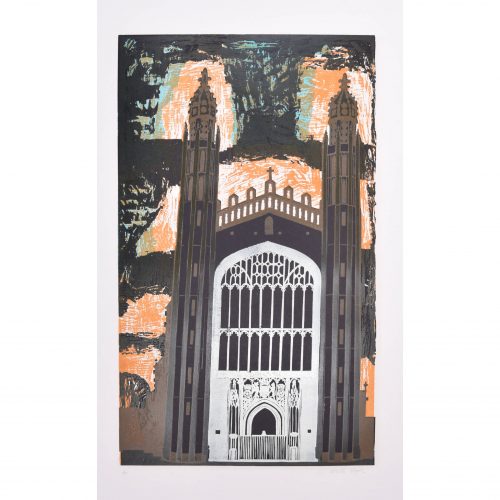
Walter Hoyle (1922 - 2000)
King's College Chapel, Cambridge (Cambridge Series 1956 - 66)
Linocut 72 x 41 cm Signed and inscribed A/P in pencil. Hoyle depicts King's College Chapel as both indomitable and delicate. The bold composition sees the chapel's spires surrounded by a fiery orange light against the black night of the background; at the same time, the western facade looks like it could have been cut from paper, or crafted from lace. Hoyle trained at Beckenham School of Art and the Royal College of Art. At the latter he was strongly influenced by Edward Bawden, one of Britain’s greatest linocut printers. Bawden had been commissioned by the 1951 Festival of Britain to produce a mural for the South Bank, and chose Hoyle to assist on account of his great talent. Hoyle moved to Great Bardfield in Essex, becoming a part of the Great Bardfield group of artists; diverse in style, they created figurative work, in stark contrast to the abstract art of the St Ives artists at the opposite end of the country. Hoyle taught at St Martin’s School of Art from 1951-60, the Central School of Arts and Crafts from 1960-64, and the Cambridge School of Art from 1964-1985, during which time he launched Cambridge Print Editions. His work is held in the collections of the Tate Gallery, the Victoria and Albert Museum, The British Museum, Kettle’s Garden and the Fry Art Gallery. Provenance: family of the artist. Condition: generally very good; a few handling marks to margins. If you are interested, please email info@manningfineart.co.uk or call us on 07929 749056. Click here for other views of King's College, Cambridge. -
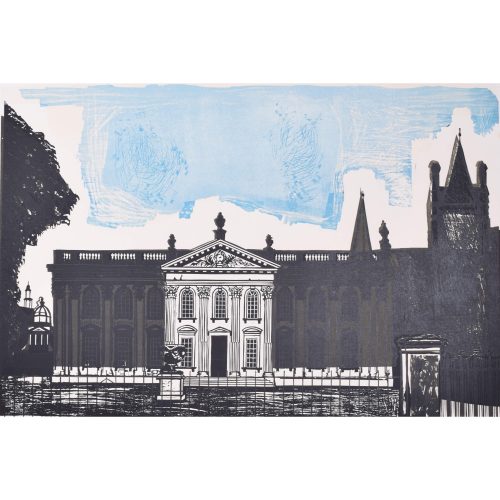
Walter Hoyle (1922 - 2000)
Senate House, Cambridge (Cambridge Series 1956 - 66)
Linocut 46 x 70 cm Trial print aside from the series, with different colourway. Senate House, under a lively blue sky. Hoyle trained at Beckenham School of Art and the Royal College of Art. At the latter he was strongly influenced by Edward Bawden, one of Britain’s greatest linocut printers. Bawden had been commissioned by the 1951 Festival of Britain to produce a mural for the South Bank, and chose Hoyle to assist on account of his great talent. Hoyle moved to Great Bardfield in Essex, becoming a part of the Great Bardfield group of artists; diverse in style, they created figurative work, in stark contrast to the abstract art of the St Ives artists at the opposite end of the country. Hoyle taught at St Martin’s School of Art from 1951-60, the Central School of Arts and Crafts from 1960-64, and the Cambridge School of Art from 1964-1985, during which time he launched Cambridge Print Editions. His work is held in the collections of the Tate Gallery, the Victoria and Albert Museum, The British Museum, Kettle’s Garden and the Fry Art Gallery. Provenance: family of the artist. Condition: generally very good; a few handling marks and areas of discolouration to extreme margins, extraneous ink to right hand side, and a very small brown spot to very top right beyond the blue sky. If you are interested, please email info@manningfineart.co.uk or call us on 07929 749056. Click here for other general views of Cambridge. -
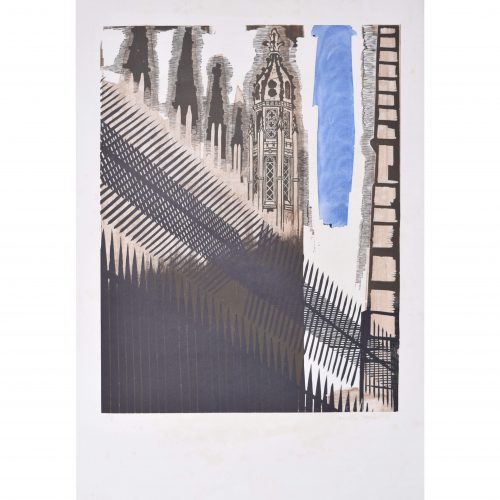
Walter Hoyle (1922 - 2000)
King's College, Cambridge (Cambridge Series 1956 - 66)
Linocut 56 x 43 cm Signed and inscribed A/P in pencil. Possibly unique. Hoyle's view of King's College, Cambridge, with a slice of blue sky behind. Hoyle trained at Beckenham School of Art and the Royal College of Art. At the latter he was strongly influenced by Edward Bawden, one of Britain’s greatest linocut printers. Bawden had been commissioned by the 1951 Festival of Britain to produce a mural for the South Bank, and chose Hoyle to assist on account of his great talent. Hoyle moved to Great Bardfield in Essex, becoming a part of the Great Bardfield group of artists; diverse in style, they created figurative work, in stark contrast to the abstract art of the St Ives artists at the opposite end of the country. Hoyle taught at St Martin’s School of Art from 1951-60, the Central School of Arts and Crafts from 1960-64, and the Cambridge School of Art from 1964-1985, during which time he launched Cambridge Print Editions. His work is held in the collections of the Tate Gallery, the Victoria and Albert Museum, The British Museum, Kettle’s Garden and the Fry Art Gallery. Provenance: family of the artist. Condition: generally very good; a few handling marks and a little age toning to the margins. Vertical impressins within and below the blue vertical area which are probably part of the artist's working technique. If you are interested, please email info@manningfineart.co.uk or call us on 07929 749056. Click here for other views of King's College, Cambridge. -

John Hoyland (1934 - 2011)
Yellows (1969)
Screenprint 56 x 94 cmArtist’s proof. Signed and dated lower right.
Hoyland's abstract print is made up of wide fields of colour, formally arranged. Paul Moorhouse wrote of the artist's ‘insistence on eliminating figurative references’, and here we have an entirely abstract composition - one which has no desire to depict anything figurative, anything tangible. The colours are vivid, with the ‘restrictive palette in which red-green oppositions are dominant’ which marks Hoyland's early work is cautiously evident here. The abstraction is deliberately imperfect: small yellow splashes break into the expanse of green, and the texture of that green overtly demonstrates its texture and madeness. Hoyland's prints are keen to remind us of the physical process of their making, relying on the tension between the formal and the informal to do so. John Hoyland was one of Britain's most revered post-war abstract artists. He was born in Sheffield and studied at the Sheffield School of Art and Crafts, and then Sheffield College of Art and the Royal Academy Schools in London. His first solo exhibition was held at the Marlborough New London Gallery in 1964. Retrospectives of his paintings have been held at the Serpentine Gallery (1979), the Royal Academy (1999) and Tate St Ives (2006). Hoyland was elected to the Royal Academy in 1991 and was appointed Professor of Painting at the Royal Academy Schools in 1999. Condition: very good; recent heavy handsome frame. Glass will be removed for international shipping. If you are interested, please email info@manningfineart.co.uk or call us on 07929 749056. Click here for other Modern British Print. -
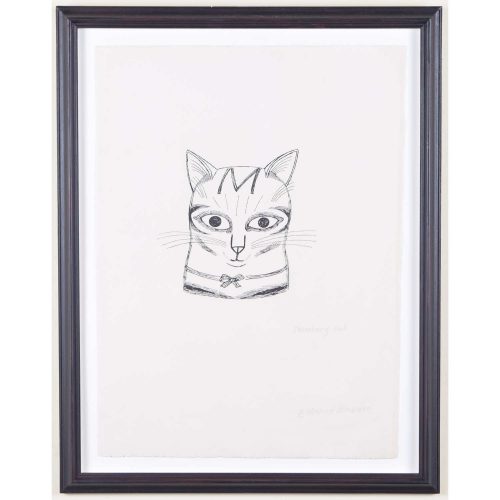
Edward Bawden (1903-1989)
Secretary Cat
Pen and ink 38 x 27 cm Signed and inscribed lower right. Bawden developed a love of cats at a young age, copying Louis Wain's cat pictures. In his later years, his drawings of cats became yet more frequent; his cat Emma featured in much of his work. In an interview with House and Garden in 1987 he said: "No cat will suffer being lifted up and dropped into an empty space intended for her to occupy; that procedure led inevitably to Emma, tail up, walking away at once, so I had to wait patiently until Emma had enjoyed a good meal of Coley and was ready to choose her daily sleeping place, wherever it might be. I would then spring into action." Doubtless he found it easier to draw an imaginary cat, such as this one. For other cats - and other works - by Bawden, please click here. If you are interested, please email info@manningfineart.co.uk or call us on 07929 749056. -

Edward Bawden (1903-1989)
Captain of the Team Cat
Pen and ink 38 x 27 cm Signed and inscribed lower right. Bawden developed a love of cats at a young age, copying Louis Wain's cat pictures. In his later years, his drawings of cats became yet more frequent; his cat Emma featured in much of his work. In an interview with House and Garden in 1987 he said: "No cat will suffer being lifted up and dropped into an empty space intended for her to occupy; that procedure led inevitably to Emma, tail up, walking away at once, so I had to wait patiently until Emma had enjoyed a good meal of Coley and was ready to choose her daily sleeping place, wherever it might be. I would then spring into action." Doubtless he found it easier to draw an imaginary cat, such as this one. For other cats - and other works - by Bawden, please click here. If you are interested, please email info@manningfineart.co.uk or call us on 07929 749056. -
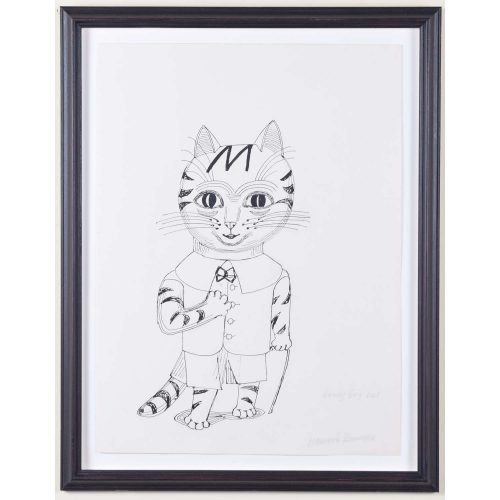
Edward Bawden (1903-1989)
Dandy Boy Cat
Pen and ink 38 x 27 cm Signed and inscribed lower right. Bawden developed a love of cats at a young age, copying Louis Wain's cat pictures. In his later years, his drawings of cats became yet more frequent; his cat Emma featured in much of his work. In an interview with House and Garden in 1987 he said: "No cat will suffer being lifted up and dropped into an empty space intended for her to occupy; that procedure led inevitably to Emma, tail up, walking away at once, so I had to wait patiently until Emma had enjoyed a good meal of Coley and was ready to choose her daily sleeping place, wherever it might be. I would then spring into action." Doubtless he found it easier to draw an imaginary cat, such as this one. For other cats - and other works - by Bawden, please click here. If you are interested, please email info@manningfineart.co.uk or call us on 07929 749056. -

Edward Bawden (1903-1989)
Hot Cat
Pen and ink 38 x 27 cm Signed and inscribed lower right. Bawden developed a love of cats at a young age, copying Louis Wain's cat pictures. In his later years, his drawings of cats became yet more frequent; his cat Emma featured in much of his work. In an interview with House and Garden in 1987 he said: "No cat will suffer being lifted up and dropped into an empty space intended for her to occupy; that procedure led inevitably to Emma, tail up, walking away at once, so I had to wait patiently until Emma had enjoyed a good meal of Coley and was ready to choose her daily sleeping place, wherever it might be. I would then spring into action." Doubtless he found it easier to draw an imaginary cat, such as this one. For other cats - and other works - by Bawden, please click here. If you are interested, please email info@manningfineart.co.uk or call us on 07929 749056. -
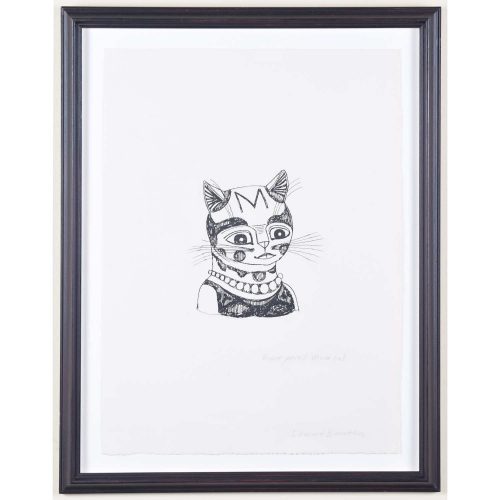
Edward Bawden (1903-1989)
House Proud Mum Cat
Pen and ink 38 x 27 cm Signed and inscribed lower right. Bawden developed a love of cats at a young age, copying Louis Wain's cat pictures. In his later years, his drawings of cats became yet more frequent; his cat Emma featured in much of his work. In an interview with House and Garden in 1987 he said: "No cat will suffer being lifted up and dropped into an empty space intended for her to occupy; that procedure led inevitably to Emma, tail up, walking away at once, so I had to wait patiently until Emma had enjoyed a good meal of Coley and was ready to choose her daily sleeping place, wherever it might be. I would then spring into action." Doubtless he found it easier to draw an imaginary cat, such as this one. For other cats - and other works - by Bawden, please click here. If you are interested, please email info@manningfineart.co.uk or call us on 07929 749056. -
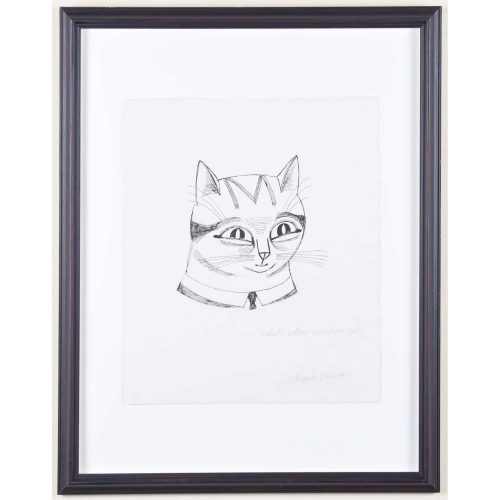
Edward Bawden (1903-1989)
White Collar Worker Cat
Pen and ink 27 x 23 cm Signed and inscribed lower right. Bawden developed a love of cats at a young age, copying Louis Wain's cat pictures. In his later years, his drawings of cats became yet more frequent; his cat Emma featured in much of his work. In an interview with House and Garden in 1987 he said: "No cat will suffer being lifted up and dropped into an empty space intended for her to occupy; that procedure led inevitably to Emma, tail up, walking away at once, so I had to wait patiently until Emma had enjoyed a good meal of Coley and was ready to choose her daily sleeping place, wherever it might be. I would then spring into action." Doubtless he found it easier to draw an imaginary cat, such as this one. For other cats - and other works - by Bawden, please click here. If you are interested, please email info@manningfineart.co.uk or call us on 07929 749056. -
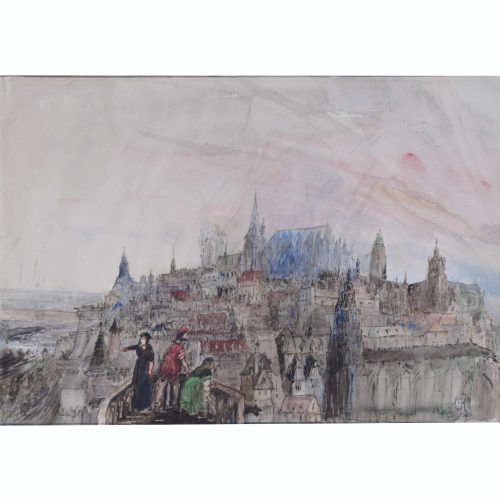
Sir Albert Edward Richardson K.C.V.O., F.R.I.B.A, F.S.A., P.R.A. (1880-1964)
The Dawn of the Renaissance in Central Europe, A Caprice
28x43cm watercolour Signed, with further detail to backboard (title, date etc.) Sir Albert Edward Richardson K.C.V.O., F.R.I.B.A, F.S.A., P.R.A. (1880-1964) was a traditionalist, renowned for his distaste of modern architecture. Rooted firmly in the classical period, he lived a Georgian life, refusing to have electricity in his Georgian house – until his wife finally insisted. Professor of Architecture at UCL’s Bartlett School of Architecture from 1929-1955, this was evacuated to Cambridge during the war and he became a fellow of St Catharine’s College. Amongst his other achievements, Richardson was President of the RA, editor of Architect’s Journal and founder of the Georgian Group. For pleasure he painted architectural fantasies; capriccios of buildings he pictured in his mind. Richardson was recipient of the Architectural Association’s Professor Bannister Fletcher Medal in 1902 which was an award for the study of post-Fire London architecture. Amongst his achievements were Professor of Architecture at University College London, President of the RA, editor of Architect’s Journal and founder of the Georgian Group. Click here for other works by the artist and biographical details. If you are interested email info@manningfineart.co.uk or call us on 07929 749056. -
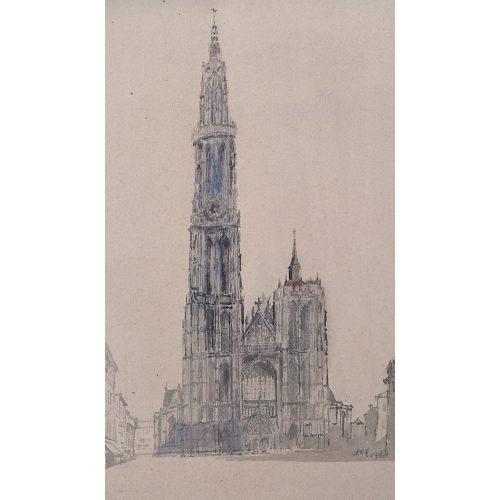
Sir Albert Edward Richardson K.C.V.O., F.R.I.B.A, F.S.A., P.R.A. (1880-1964)
Antwerp Cathedral
33x20cm Watercolour Sir Albert Edward Richardson K.C.V.O., F.R.I.B.A, F.S.A., P.R.A. (1880-1964) was a traditionalist, renowned for his distaste of modern architecture. Rooted firmly in the classical period, he lived a Georgian life, refusing to have electricity in his Georgian house – until his wife finally insisted. Professor of Architecture at UCL’s Bartlett School of Architecture from 1929-1955, this was evacuated to Cambridge during the war and he became a fellow of St Catharine’s College. Amongst his other achievements, Richardson was President of the RA, editor of Architect’s Journal and founder of the Georgian Group. For pleasure he painted architectural fantasies; capriccios of buildings he pictured in his mind. Richardson was recipient of the Architectural Association’s Professor Bannister Fletcher Medal in 1902 which was an award for the study of post-Fire London architecture. Amongst his achievements were Professor of Architecture at University College London, President of the RA, editor of Architect’s Journal and founder of the Georgian Group. Click here for other works by the artist and biographical details. If you are interested email info@manningfineart.co.uk or call us on 07929 749056. -
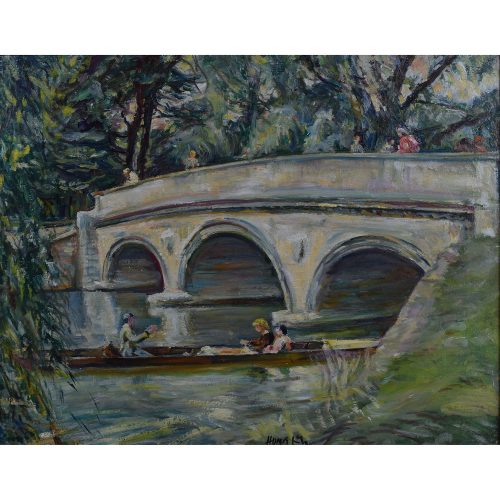
Nancy Weir Huntly (1890-1963)
Trinity College Bridge Cambridge
Oil on canvas; framed in an antique-white-finished frame with gilt slip. Signed 'Huntly' 50x61cm Born in India, in Nusserabad, she studied art at the Royal Academy Schools in Dusseldorf. She lived in Welwyn Garden City, in Hertfordshire, with her daughter, Faith Sheppard, also a painter. She also painted under the name Nancy Sheppard. If you are interested email info@manningfineart.co.uk or call us on 07929 749056. -
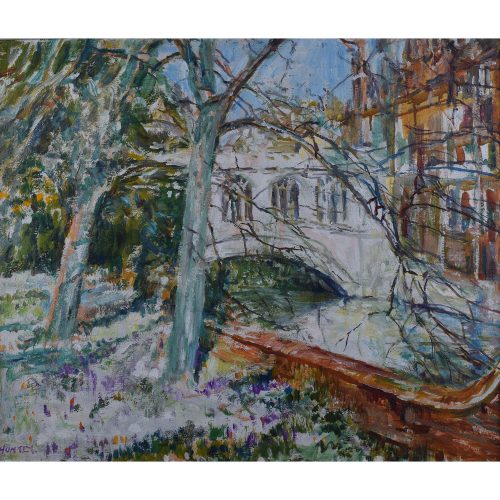
Nancy Weir Huntly (1890-1963)
St John's College Bridge of Sighs Cambridge
Oil on canvas; framed. Signed 'Huntly' 50x61cm Born in India, in Nusserabad, she studied art at the Royal Academy Schools in Dusseldorf. She lived in Welwyn Garden City, in Hertfordshire, with her daughter, Faith Sheppard, also a painter. She also painted under the name Nancy Sheppard. If you are interested email info@manningfineart.co.uk or call us on 07929 749056. -
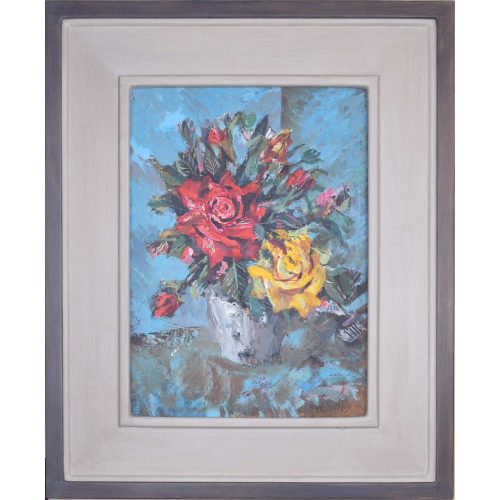
Rowland Suddaby (1912-1972) English Roses - Still Life
Oil on board 39x29cm (frame 58x46cm) c. 1950s Artist's label to reverse In a fine hand-finished frame Born in Kimberworth, Yorkshire, Suddaby commenced study in 1926 at the Sheffield College of Art on a scholarship, coming to London at nineteen in 1931. Following an early marriage and an initial struggle as an artist his first successful show was at the Wertheim Gallery in London in 1935, followed by a series of shows at the Redfern Gallery from 1936. For the latter he was their replacement for Christopher Wood (who had sadly killed himself in 1930 by jumping under a train) and he painted assured oils and watercolours - some showing Wood influences - in London and Cornwall. Popular with both art critics and the buying public he had great success. Early in World War Two, Suddaby moved - with his family - to the Suffolk countryside near Sudbury to become curator of the Gainsborough's House Museum, East Anglia providing him with the foundations for the pictures for which he is now well known. In 1940 he was chosen for the 'Recording Britain' project. Showing something of the influence of John Nash, his distinctive depiction of the East Anglian countryside, with its hedges and fences is instantly recognisable. His still life paintings which he also painted in the 1940s and 50s were exhibited at the Leger Galleries and at the Colchester Art Society of which he was a founder member. By the 1960s he had evolved his style towards abstraction. He was also a noted designer, producing textiles and furnishings and designing posters for Shell. His work is in many major collections such as the V&A Museum and the Government Art Collection If you are interested email info@manningfineart.co.uk or call us on 07929 749056. Condition: Good. -
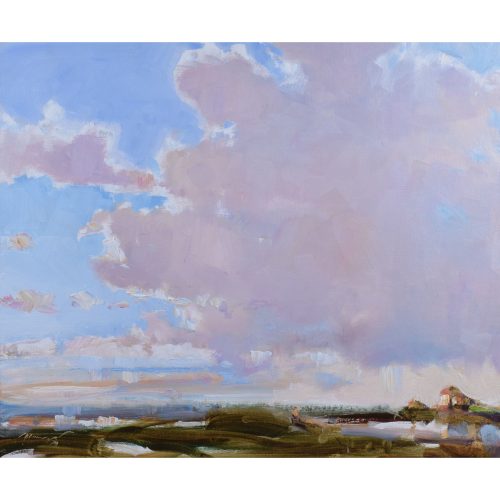
Ken Moroney (British, 1948-) The Fens, Norfolk (c. 1990)
Oil on canvas board 48 x 58 cm Provenance: Bonhams (2003) Of Anglo-Irish parentage, Moroney was born in South London, and showed early artistic talent. His Irish father, finding it unmanly, encouraged him to box, and whilst a teenager Moroney won a gold medal. However this did not distract him from art, and once his boxing hobby came to an end the paints continued to show his flair. Self-taught, his impressionistic style, with bold use of colour, has found widespread favour and his works now hang in many important collections. Here he captures the many colours often visible in a fenland sky, where the flat landscape makes for huge skies. If you are interested email info@manningfineart.co.uk or call us on 07929 749056. Condition: Excellent. -
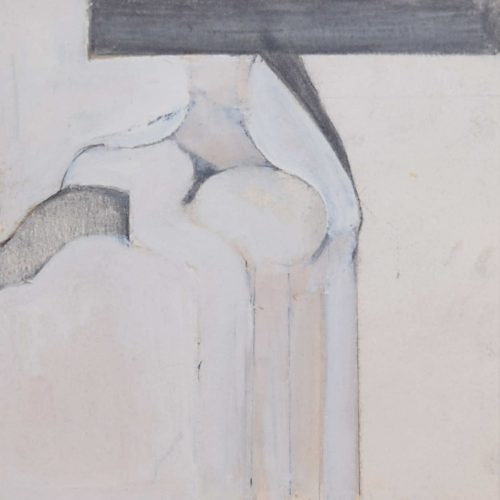
Adrian Heath Abstract Study III (1975)
Acrylic and pencil on paper 22 x 22cm Heath was born in Burma in 1920 and arrived in England aged five. In 1938 he studied art under Stanhope Forbes at Newlyn and later at the Slade School of Art. While serving in WWII, he was captured and placed in a prisoner-of-war camp in Bavaria. Heath attempted to escape from the camp but was recaptured and placed in solitary confinement; this isolation proved crucial to the development of his artistic style, as he spent much of his time there experimenting with abstract forms. When released from confinement, Heath befriended a fellow prisoner of war: Terry Frost. Together they explored the methods of painting which they had developed during their time in the camps, and following the war both became celebrated artists. We have several Terry Frost pieces available too. In 1949 and 1951, Heath returned to Cornwall. He spent time with artists like Ben Nicholson, Victor Pasmore, and Anthony Hill, and became the main link between the emerging St Ives School of artists and the British Constructivist movement back in London. He is further credited with promoting British abstract art through informal exhibitions in his studio on Fitzroy Street, as well as his manifesto-like text entitled 'Abstract Art: Its Origins and Meaning', which was published in 1953. Over time, Heath's paintings of abstract geometry and symmetry became increasingly dynamic and heavily textured, the result of layering paint on paint over the course of several days. This study features a muted colour palette and abstract asymmetric form. If you'd like to know more, please email info@manningfineart.co.uk or call us on 07929 749056. Condition: Good. Signed lower right. -
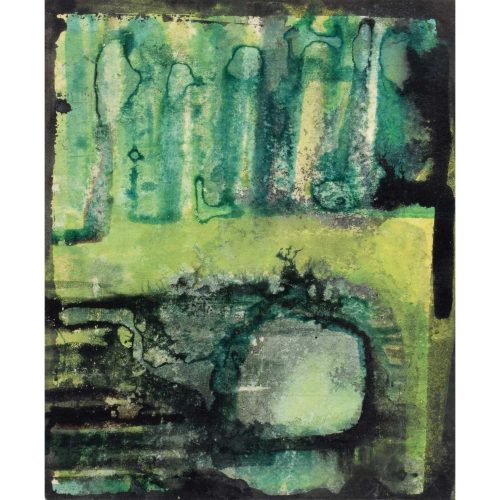
John Piper (1903-1992)
Study for the Piper Building mural
Gouache 14.5x11.5cm Provenance: P Manzareli (who built the fibreglass murals for Piper), gift from the artist; Milne & Moller Fine Art; Katharine House Gallery; private collection, Scotland. This study is a fascinating part of London's architectural history. The Piper Building is a mid-century architectural icon in Fulham. Built in the 1950s as 'Watson House', it was a laboratory complex for the North Thames Gas Board and has an innovative concrete structure. Piper was commissioned to produce the murals surrounding the building. The Gas Board moved out in the mid 1980s. Scheduled for demolition in the 1990s, the building was instead converted into seventy apartments and renamed the Piper Building. With double-height ceilings, the apartments were sold as shells, and purchasers were free to commission their own architects and builders. Condition: Generally excellent; framed. For other works by the artist and biographical details, click here. If you are interested email info@manningfineart.co.uk or call us on 07929 749056. -
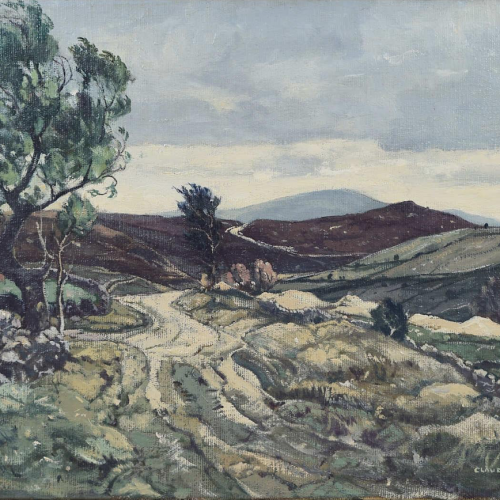
Claude Muncaster Moor above Llangollen
Oil on canvas 36 x 51 cm Condition: Excellent, recently cleaned and revarnished. Signed lower right. Click here for biographical details and other works by the artist. If you are interested, email info@manningfineart.co.uk or call us on 07929 749056.

